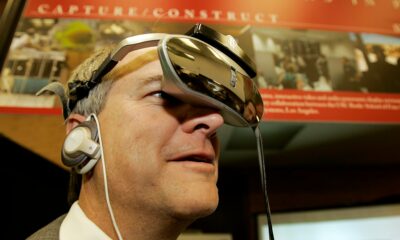SEO
5 SEO Insights to Learn From
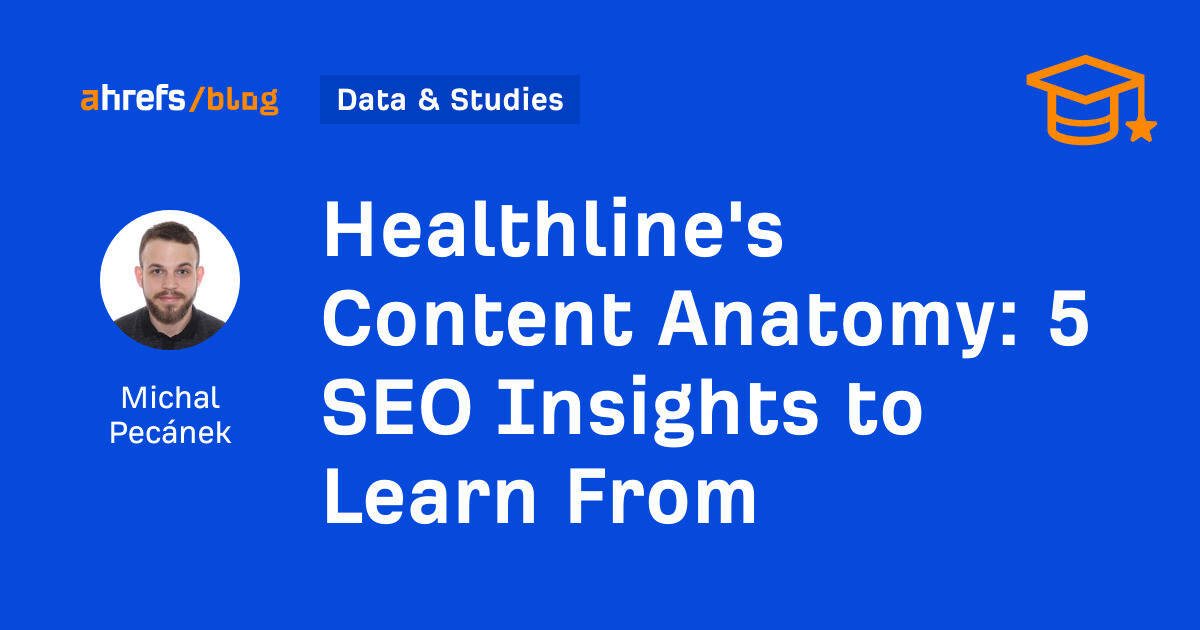
Healthline is one of the biggest health niche websites. We’re talking tens, if not hundreds of millions of clicks every month with fierce competition. It doesn’t get much more exciting in SEO than this.
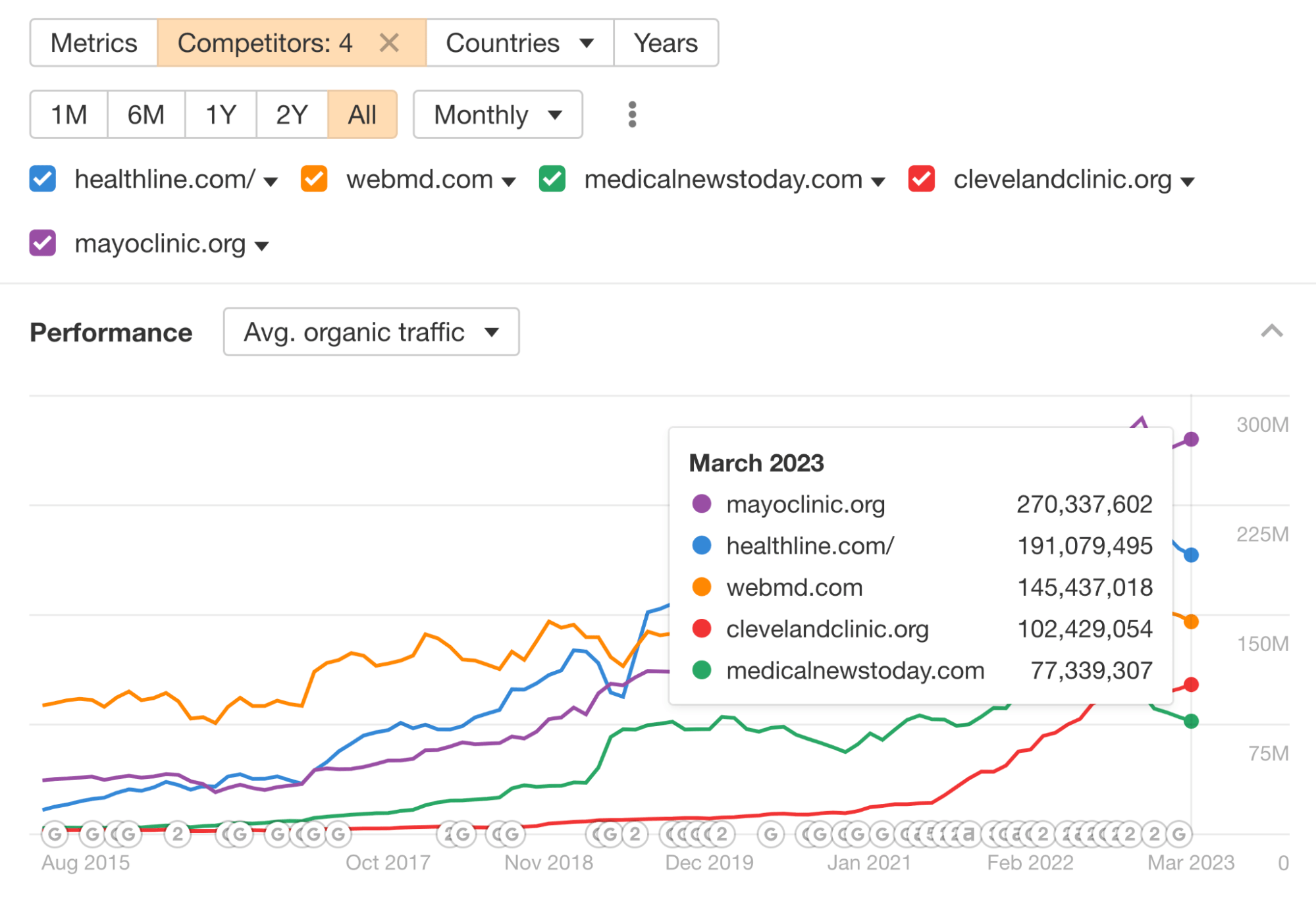
Healthline is owned by media giant company Red Ventures, which has a whole RVO Health subdivision comprising many domains in this YMYL niche. One of them is also Medical News Today that you can see among the biggest players listed in the chart above.
All of these websites are SEO powerhouses we can learn from, but I found Healthline to be the most interesting one, especially its content and on-page aspects. Let’s take a look at five insights that stood out to me from many hours of analysis.
It’s hardly a surprise that you’ll find patterns after publishing tens of thousands of pieces of content. In Healthline’s case, it currently has around 34K pages in its Health and Nutrition article subfolders that drive the vast majority of its traffic:
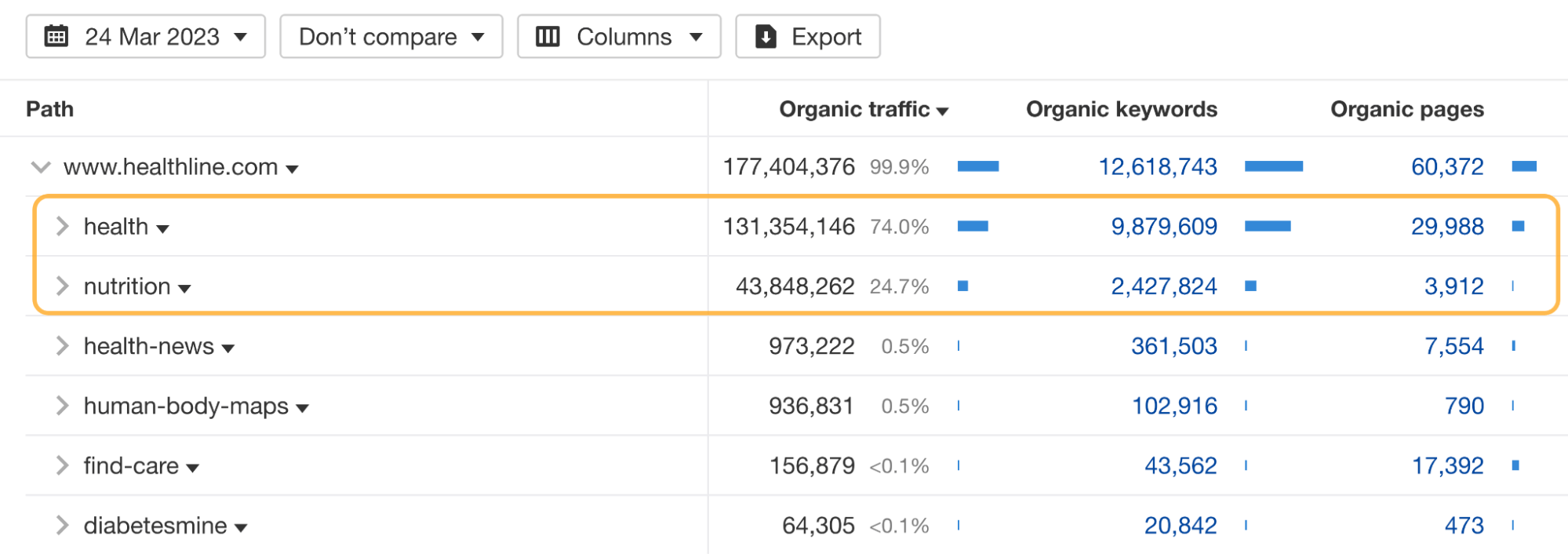
Certain types of content, like food item overviews, can be templated pretty heavily, as you can see from the title tags and H2s here:
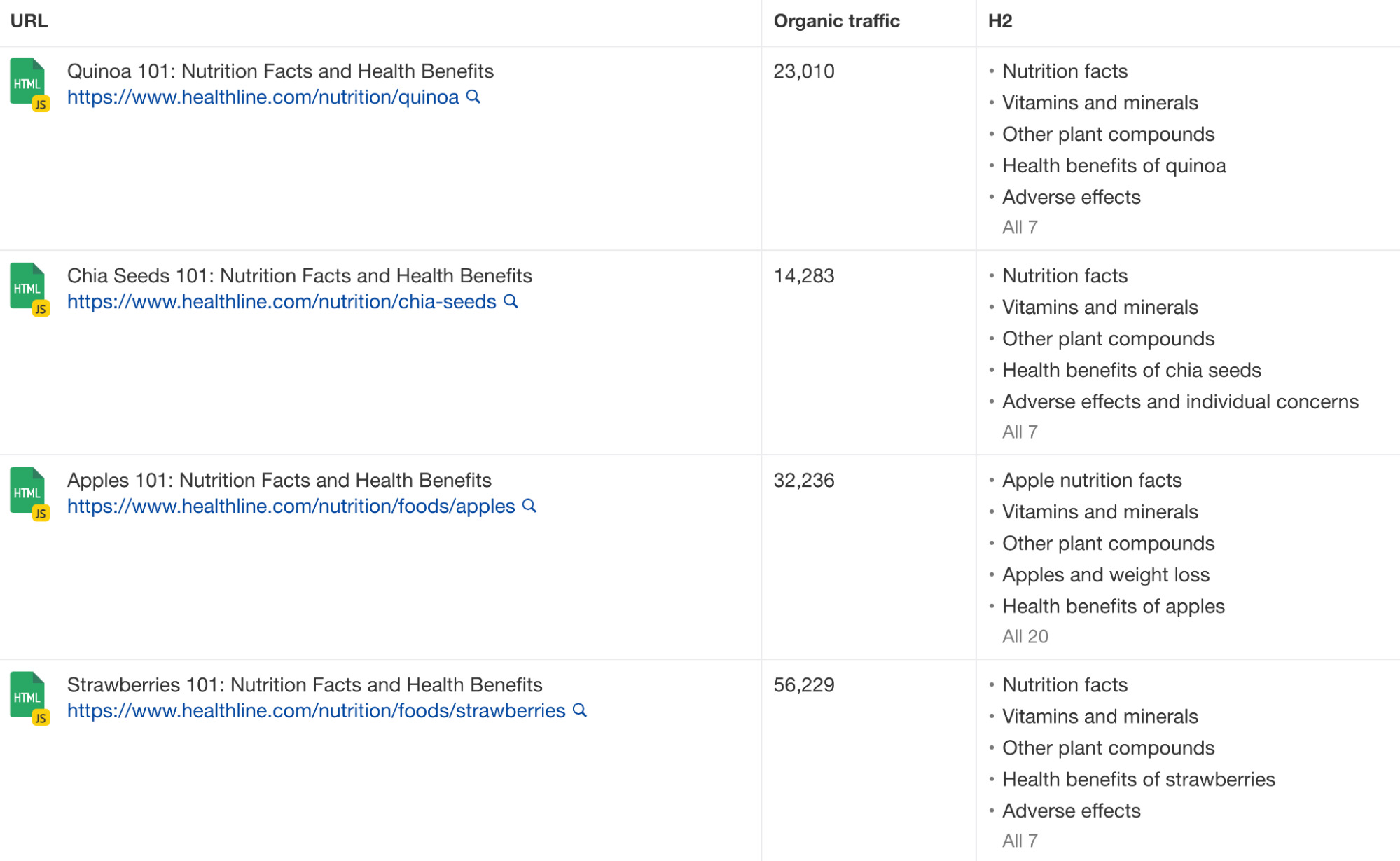
But more often than not, you’ll need some more unique points and headings to align perfectly with the search intent.
For example, here are three SERP snippets that use the same title tag template that tells you the focus of the article.
We have crackling in ear…

Followed by wrist pain…

And ending with contact dermatitis.

Causes, symptoms, and treatment are variables the vast majority of searchers will be interested in when looking up these health problems.
But crackling in ear can be something you may be able to fix easily with home remedies:
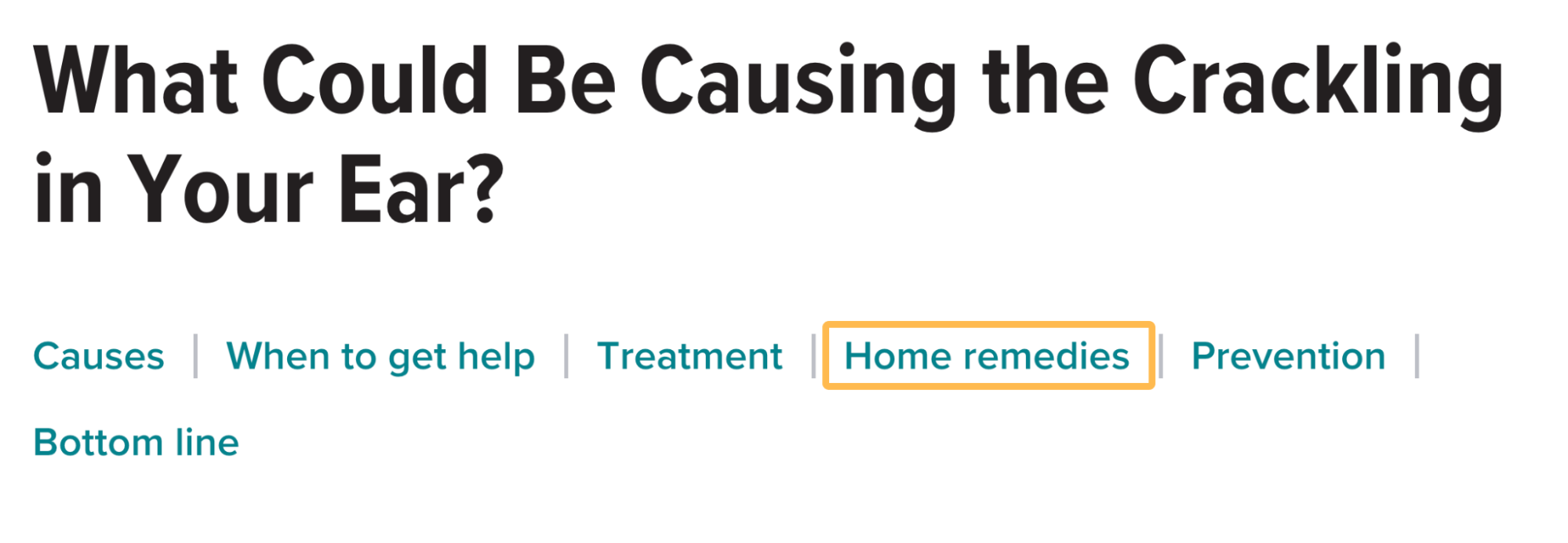
Wrist pain usually requires you to do some exercises to get better:

And contact dermatitis is something you likely need to see photos of to confirm if you landed on the right health problem:

All of these articles have huge structural overlaps but are still unique in one way or another, which makes them great for answering all sorts of questions a searcher may have.
Healthline uses the title template of {health problem} followed by the most relevant combination of words like causes, symptoms, treatment, diagnosis, risks, preventions, pictures, etc., across the board.
It sounds simple. But choosing the right combination that best aligns with the search intent results in SERP titles that are better—or at least on par with the competition:

And this goes on and on throughout different content types. Here, we have a bunch of pages where people are likely most interested in the difference:

While others are positioned toward picking a winner for a certain quality (better, healthier, etc.):
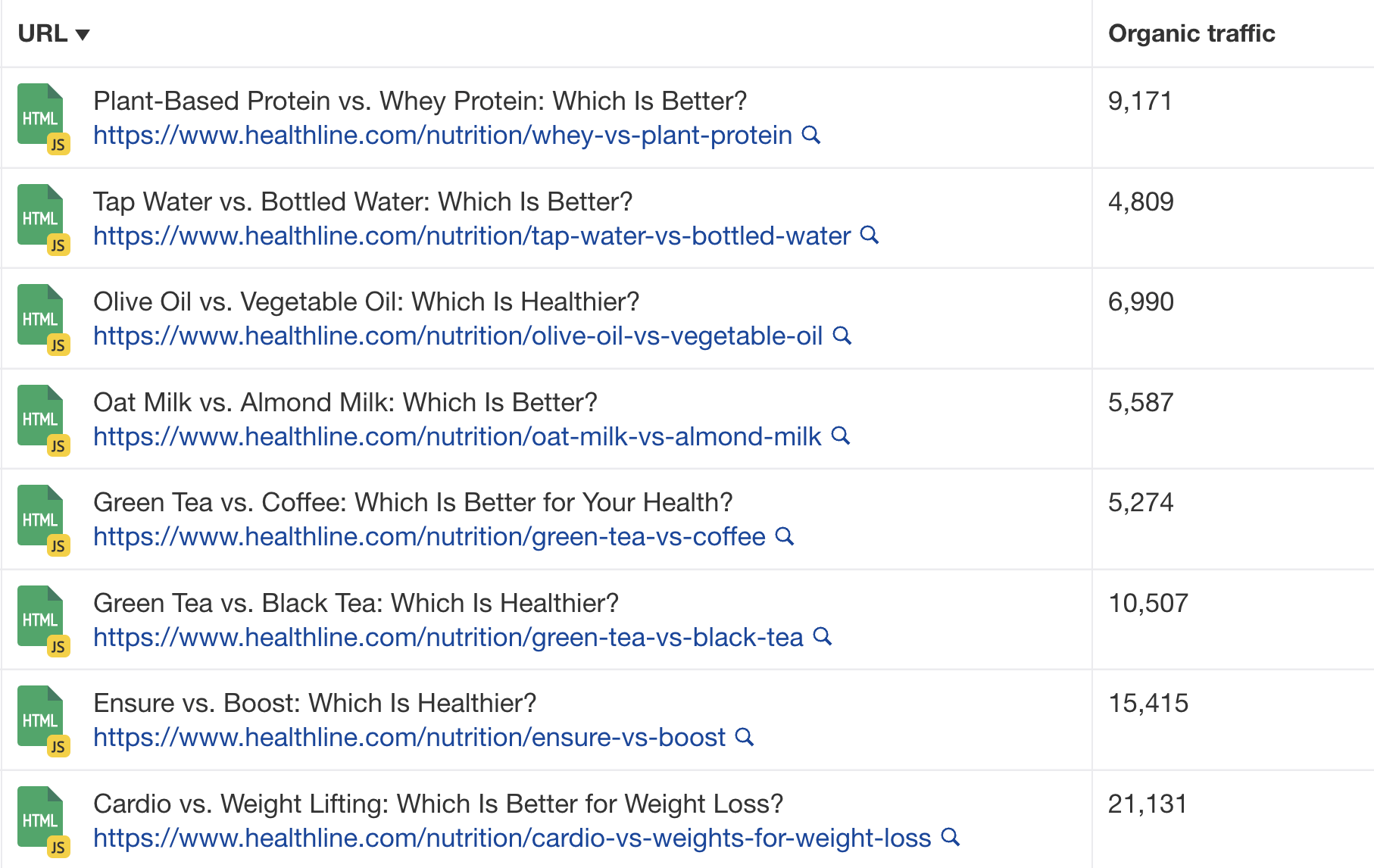
Nailing search intent alignment is one thing. But being able to do it with multiple pieces of content that have huge target keyword overlaps is an advanced SEO and content game.
I think most people associate ranking for one keyword using multiple pieces of content with a phenomenon that hurts one or more of these pages. This is known as keyword cannibalization.
But take a look at this:

As someone who’s done a bit of research about creatine in the past, I can see myself clicking on both of these results. They cover the topic from different angles that don’t result in cannibalizing each other’s organic traffic.
Anyway, you can’t even cannibalize your own content when you already rank at the top with one of those pages. Occupying more search results simply gets you more traffic.
There are currently over 40K keywords in the U.S. where Healthline owns the top SERP position and one or more lower positions:
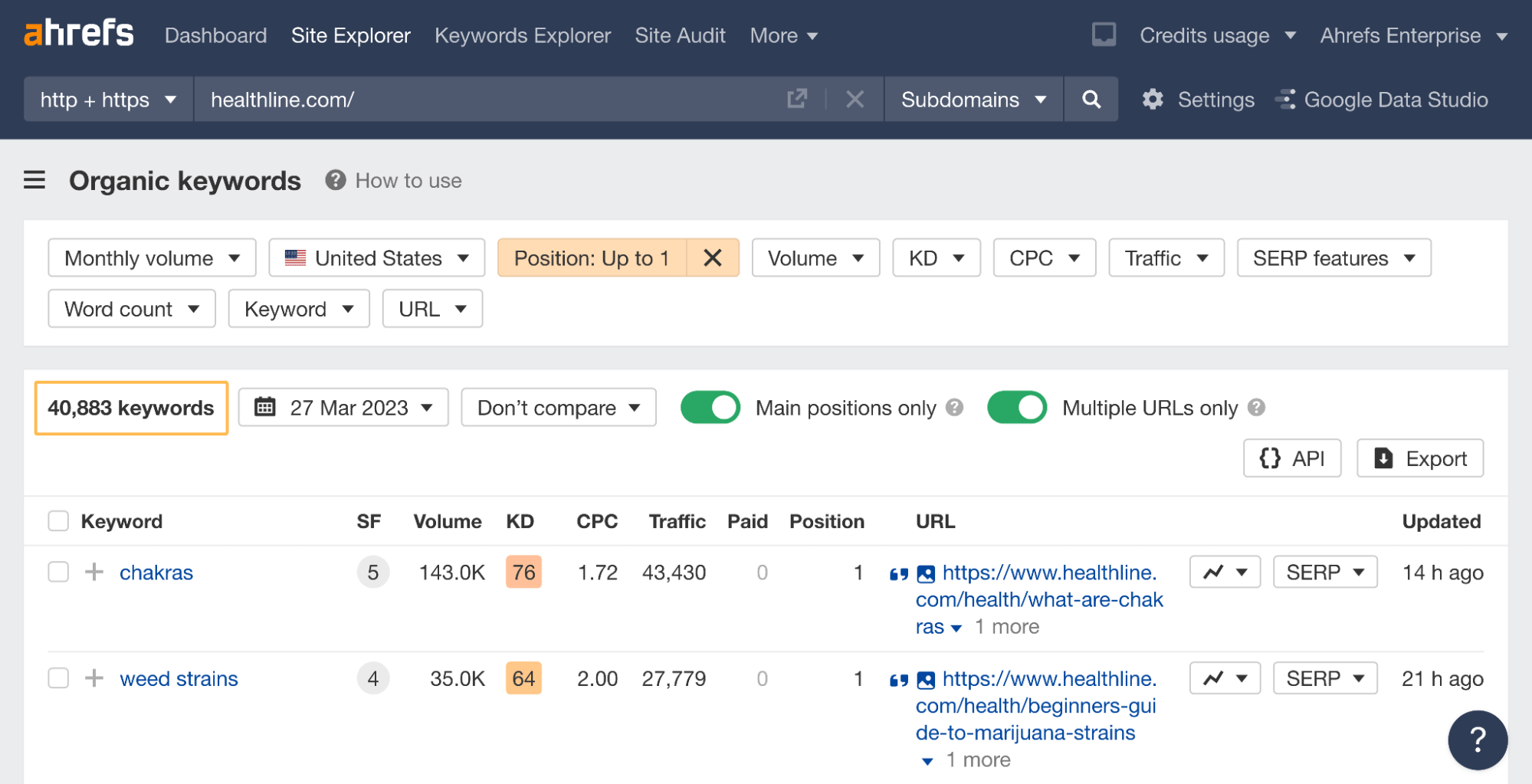
Not all of these keywords have a mixed search intent, though.
In some of these cases, Healthline likely ranks with more pieces of content that serve the same purpose just because it is a huge authority in the space. I didn’t encounter this from examining many of its SERPs. But the following data speaks for itself.
What surprised me the most is the fact that out of the 1K keywords with the highest search volume here, it manages to rank for 994 of them with two or more results in the top 10 search results:
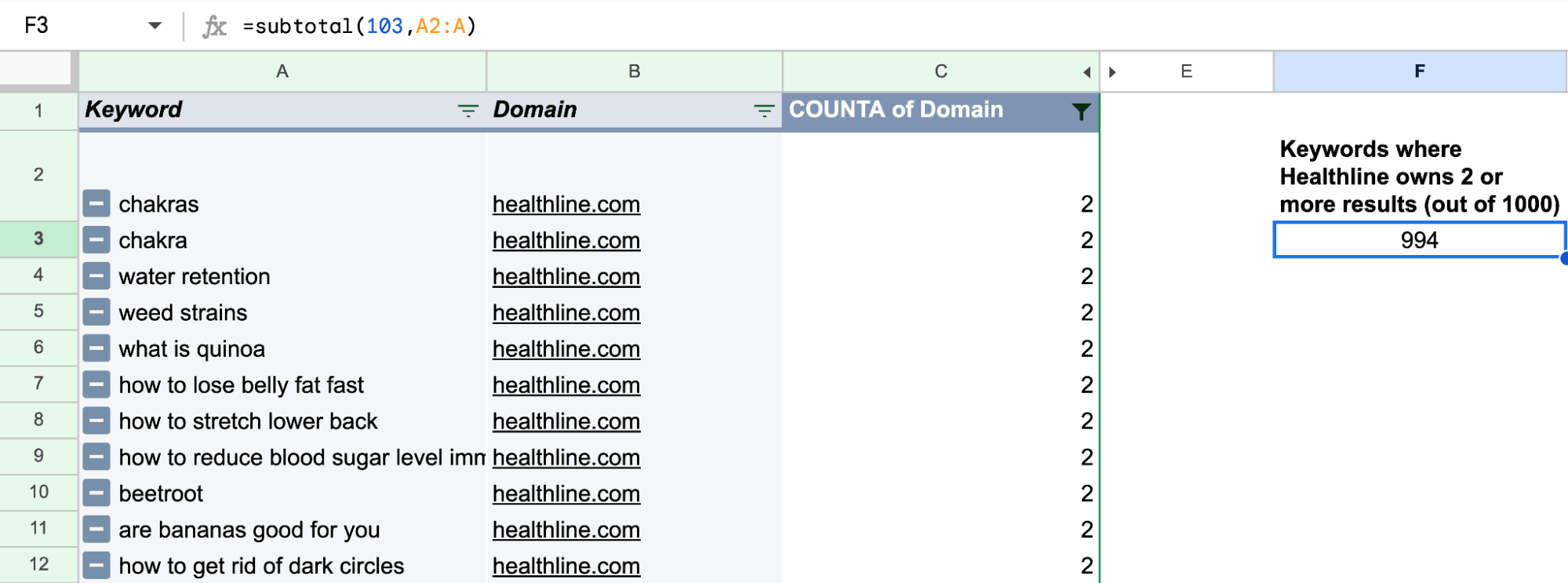
Last but not least, another way of taking more SERP estate is to rank with both written content and videos. You guessed it. Healthline also has a thriving YouTube channel, and it manages to own multiple results in this manner as well:
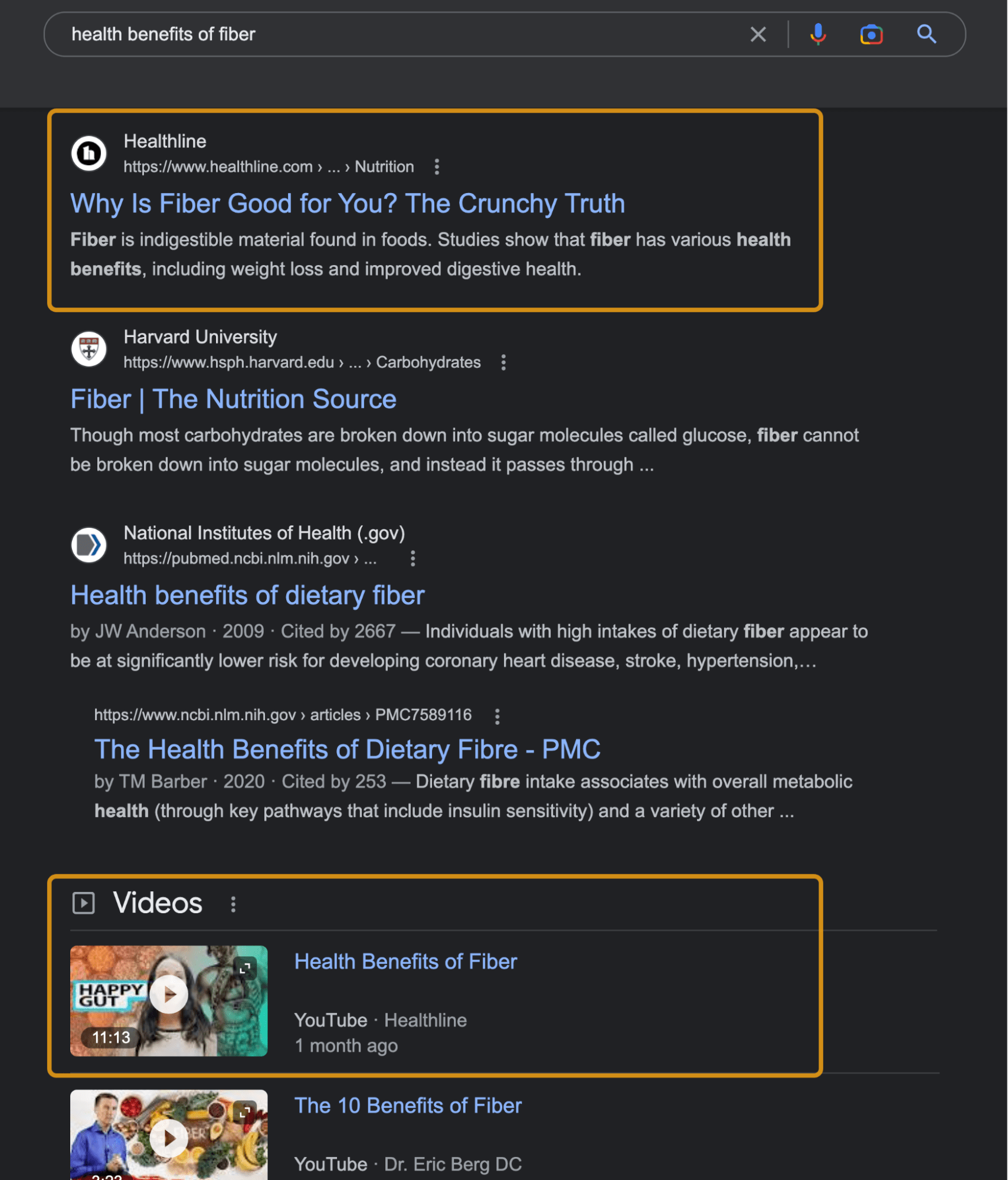
Two confessions: I hate the UX of most websites with display ads, and I often refer to engagement metrics like bounce rate as vanity metrics.
Yet I find the experience of browsing through Healthline smooth, with many nudges to keep me engaged with it longer. And I’m sure its team does a great job of doing visitor engagement analysis and goal setting.
There are three aspects worth taking a closer look at because SEO and UX are closely intertwined disciplines.
Keeping ads in moderation
Display ads, pop-ups, and interstitials are usually a nightmare for many browsing experiences without an ad blocker. (Are you really a marketer if you’re using one?)
Healthline seems to have found a great balance between monetization and user experience. Especially on desktop, it doesn’t stuff ads in between paragraphs, which I highly appreciate. I don’t mind seeing the ads at the top of the content or on the side:
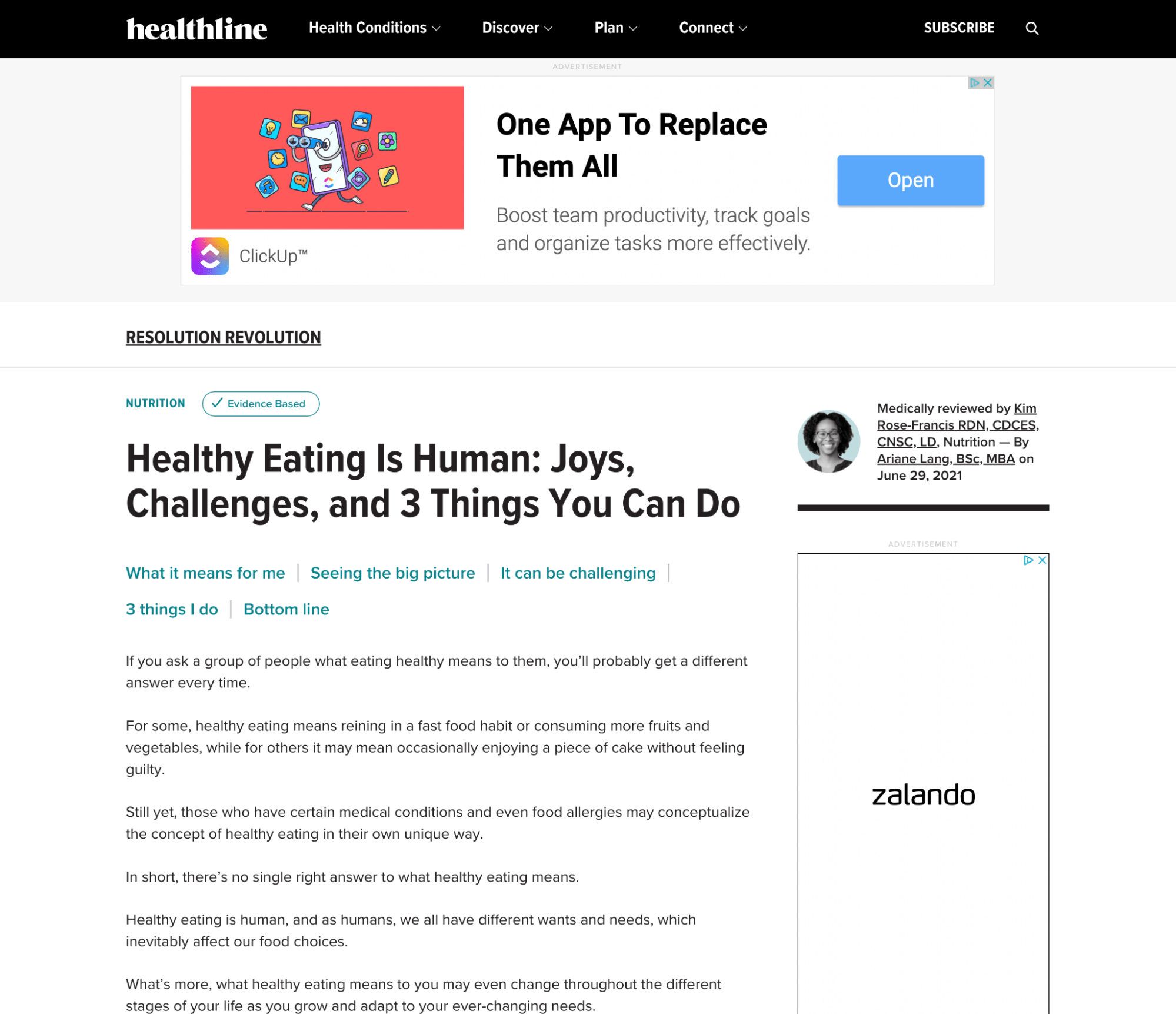
The experience obviously gets worse on mobile, as there is no sidebar. But the ads within the content still aren’t overwhelming. It also applies to pop-ups, as I only recall getting one for an email newsletter subscription, which is totally OK from time to time.
Infinite scrolling
A lot of Healthline articles use an infinite scroll feature where you seamlessly “flow” into reading another article related to the one you landed on. The URL changes as you go along.
For example, here’s an ending of a Beetroot 101 article that flows into the health benefits of beets with an ad in between:

I got into reading some Healthline articles and sometimes didn’t even realize that I was already reading another piece of content. It nails down the relevance, making the reader stay on the page longer, which naturally results in more monetization opportunities.
Chances are that it’s also a positive SEO signal, but we’re getting into speculations here. No one officially confirmed signals like dwell time to be a ranking factor.
Truly related content suggestions
The key factor in keeping readers engaged with more content is the relevance of the suggestions. We already showed an example of infinite scroll, but Healthline also employs other content suggestion methods.
There’s a well-known “related reading,” or as Healthline titles it, “read this next” section. For example, these are suggestions at the end of an article with the title “Healthy Eating Is Human: Joys, Challenges, and 3 Things You Can Do”:
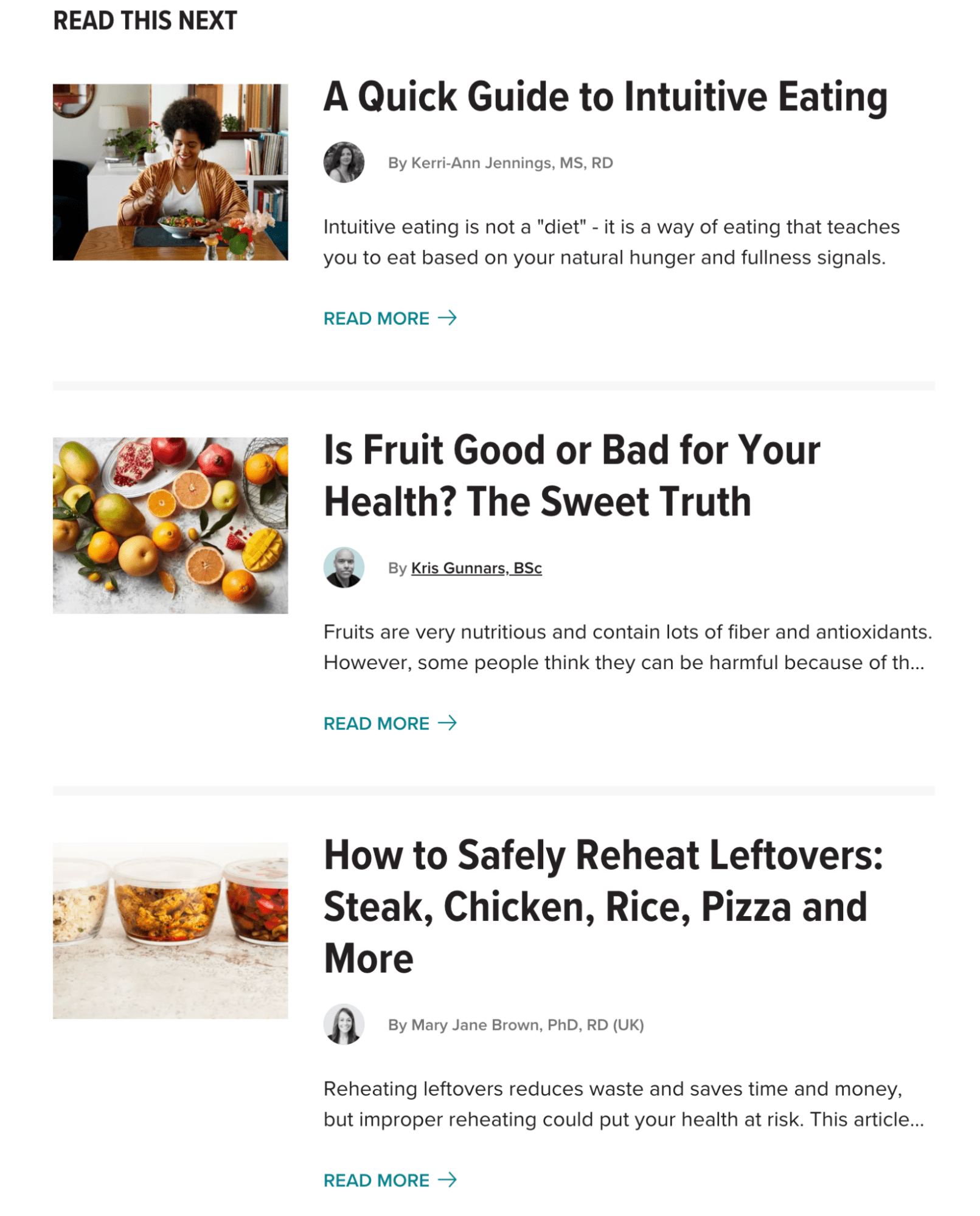
Looks good to me. What also looks good are its “related videos” sections to provide content in different formats, like this one in between the list of the “healthiest vegetables around”:
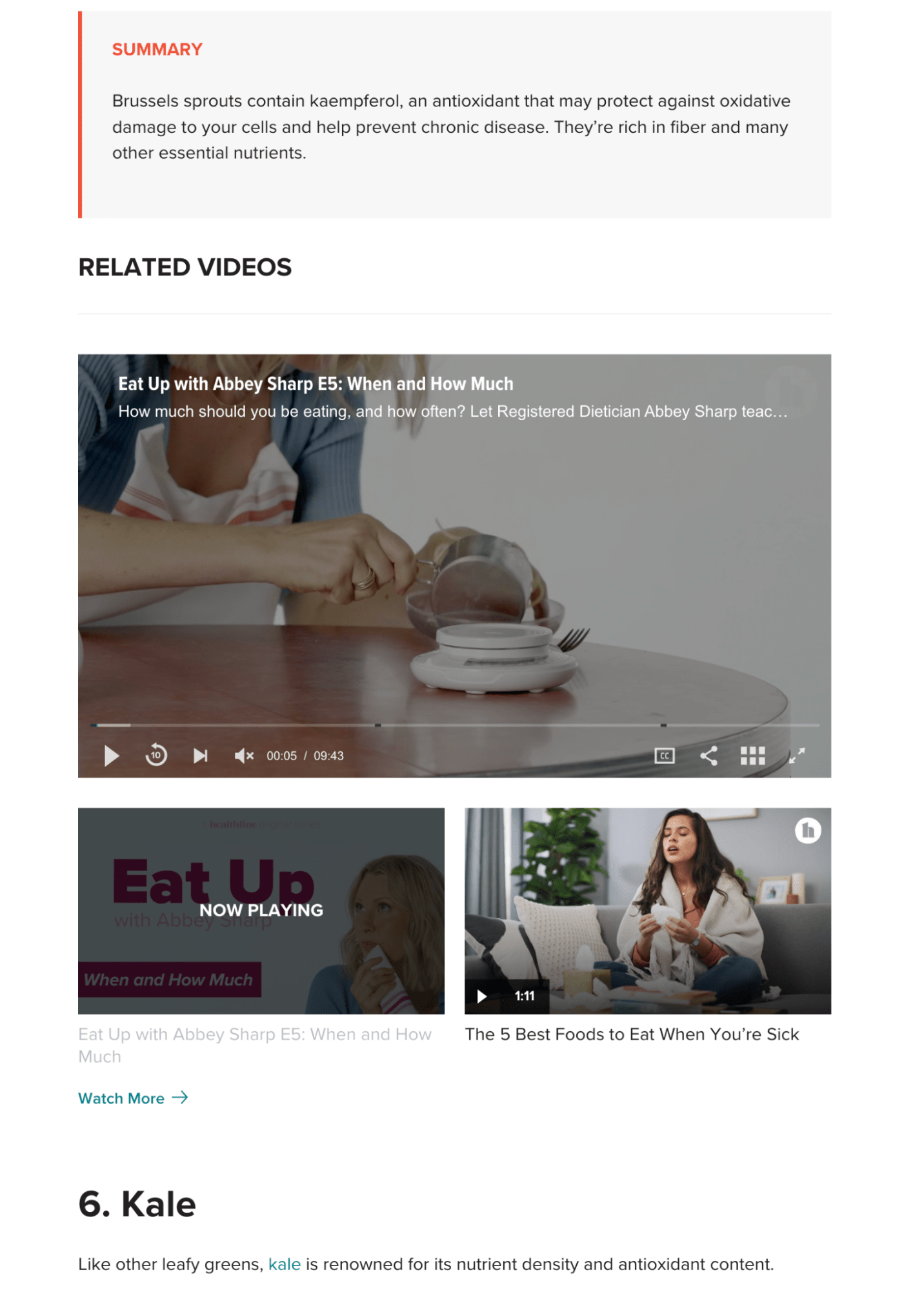
Being able to show video ads in there is just the cherry on the top.
The great relevance of all the suggested articles and videos we just covered makes me wonder how Healthline manages to do that. It’s unlikely that it selects these manually at this scale.
I encountered what seems to be a multi-level system of content tagging that could play a big role in creating this content recommendation system.
Healthline uses a combination of different meta tags, like on this page about losing weight:
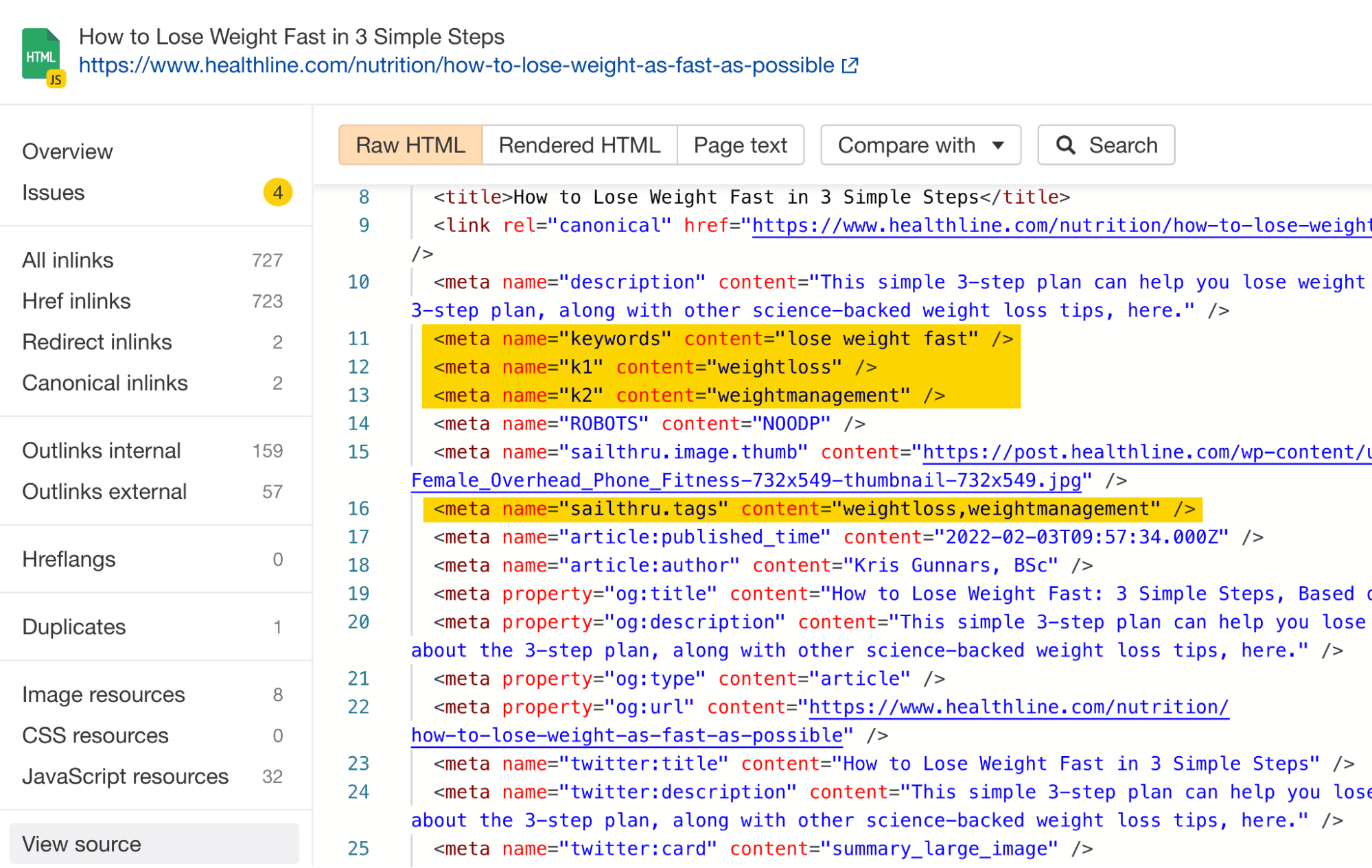
Yes, the long-dead meta keywords can still be encountered. While they don’t play any role in rankings (at least not for Google), they can come in handy for tagging the topics of each piece of content to create an internal topical hierarchy. Some advanced CMSes (like the headless ones) recommend doing it for this purpose too.
The sailthru.tags is a meta tag for categorization and user interest tracking used for a personalization engine. Healthline takes catering to search intent and users’ interests very seriously.
I made an assumption that it’s also serious about engagement tracking and goal setting. Well, there are lots of custom dimensions it sends to its Google Analytics, including these content tags:
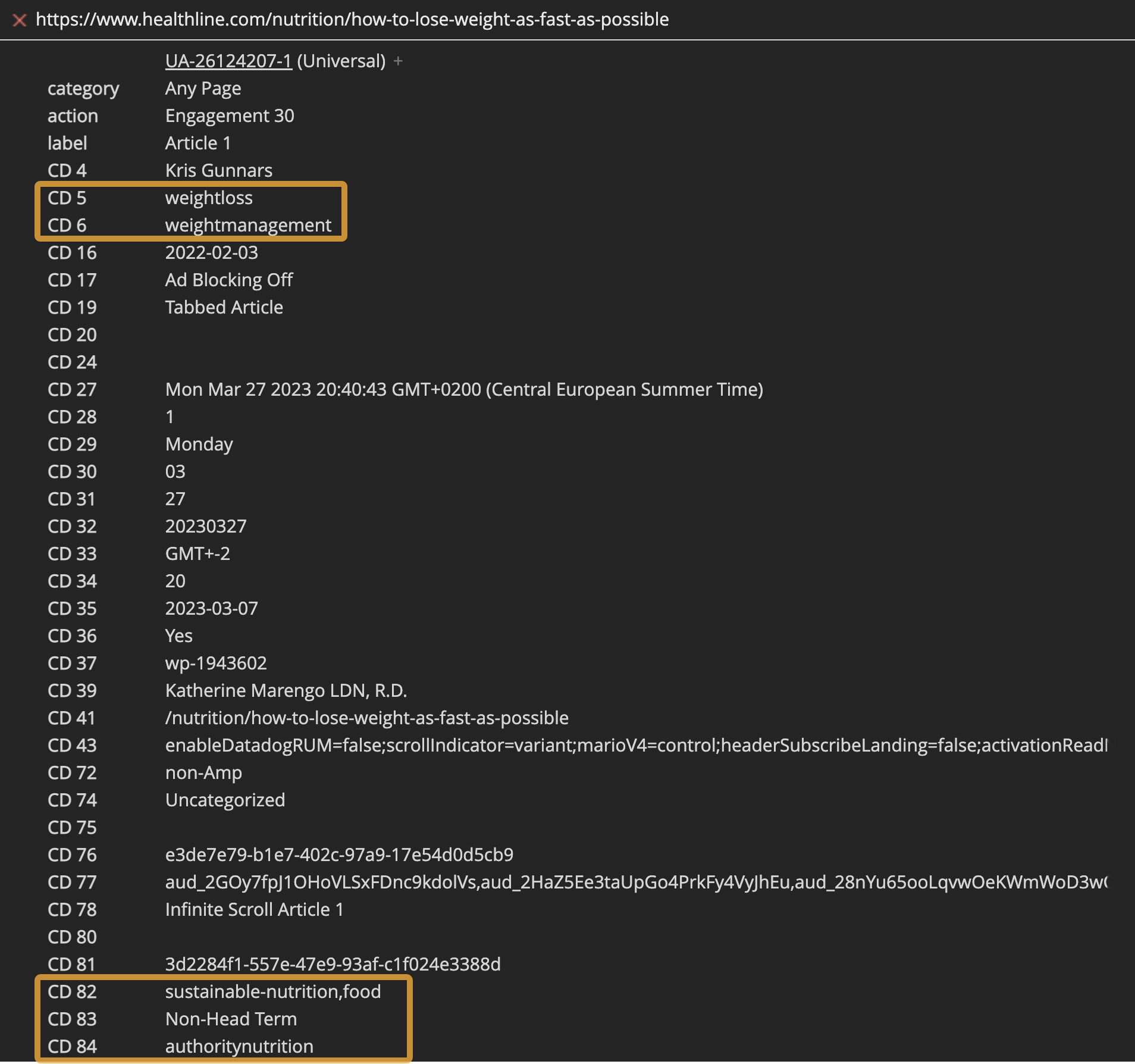
It will hardly surprise anyone that a successful website with 100% YMYL content excels in signaling E-E-A-T. But there are many aspects of this worth bringing up.
Most relevant authors and reviewers
It should go without saying that your authors should be qualified to cover their assigned topics, especially in YMYL niches. Healthline does a great job here.
It has a team of in-house writers and guest freelancers with various qualifications related to health and medicine. These people don’t necessarily need to be experts in a certain topic, but their backgrounds ensure that they can put together great content:
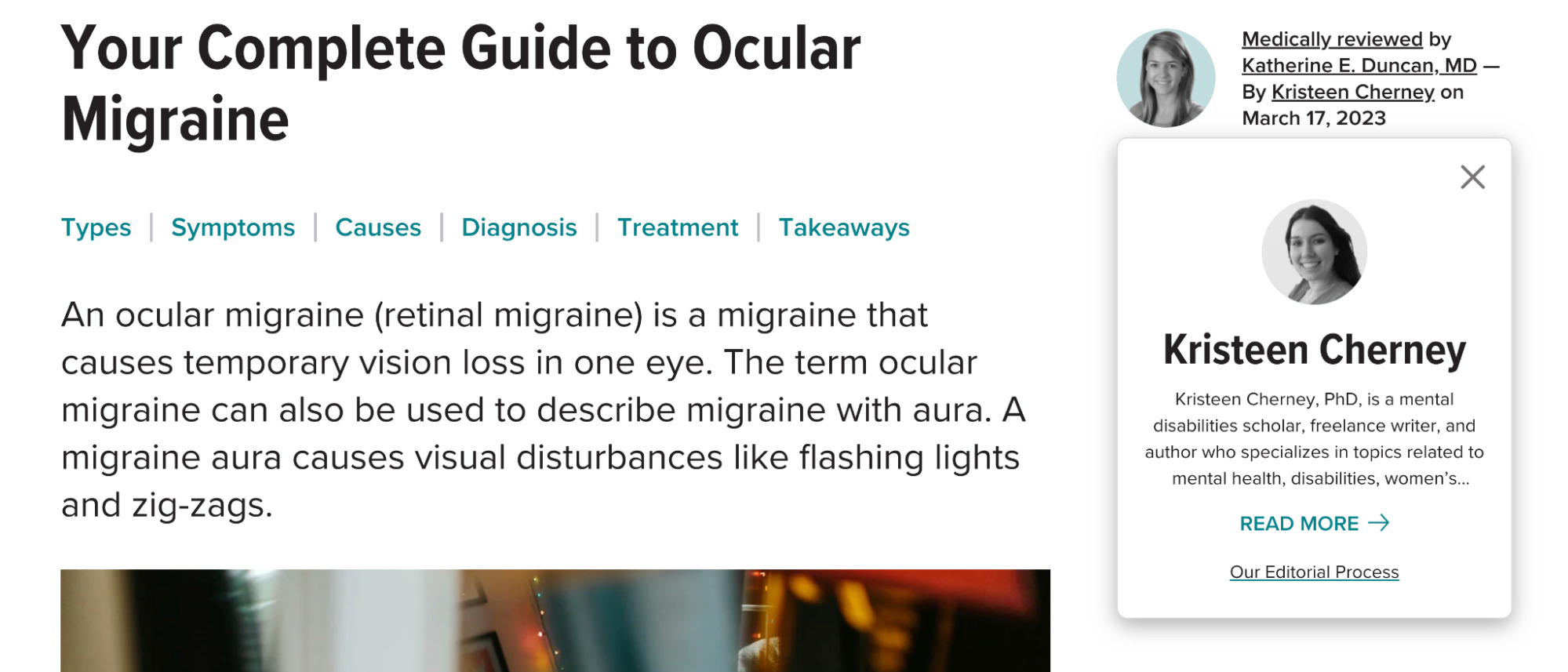
Then the experts come into play in the medical review. In this example, there’s no one more qualified for the job than an ophthalmologist:

Healthline’s medical team consists of four divisions that create a huge professional network with expertise for likely any medical topic you can think of:

Awards, accomplishments, citations, and backlinks of authors and reviewers
We have all encountered a few doctors that left us wondering how they even finished med school. Having a diploma is simply just a prerequisite. Given that E-E-A-T is largely about backlinks and references, it’s likely a good idea to get people with a successful track record.
Everyone I clicked on on Healthline seems to have great professional backgrounds and credentials:
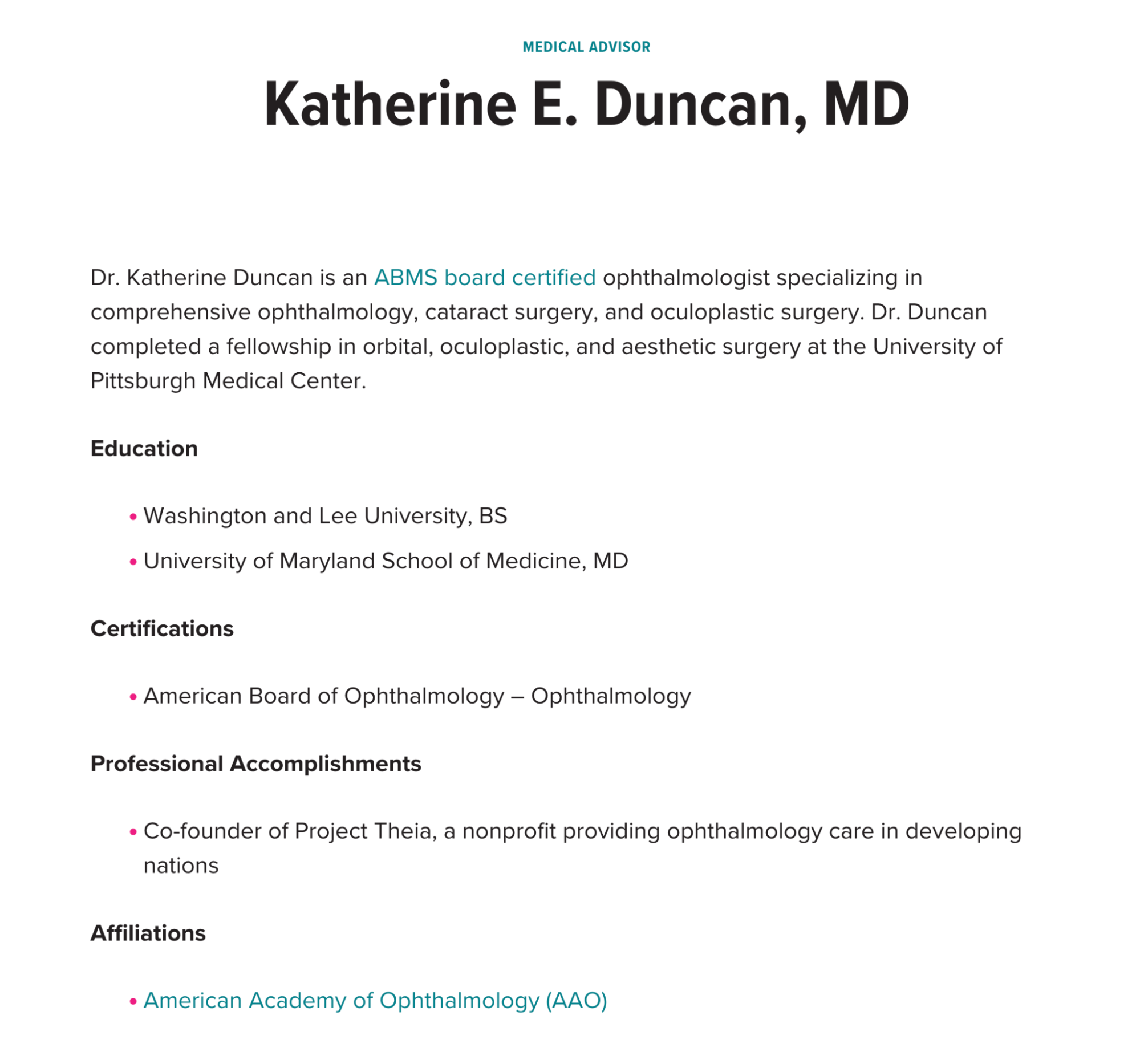
Diving into stuff like h-index or other author-level metrics seemed like an overkill here, so I at least looked up a few authors and reviewers in Google Scholar. Almost everyone returned relevant papers and articles from the Scholar index.
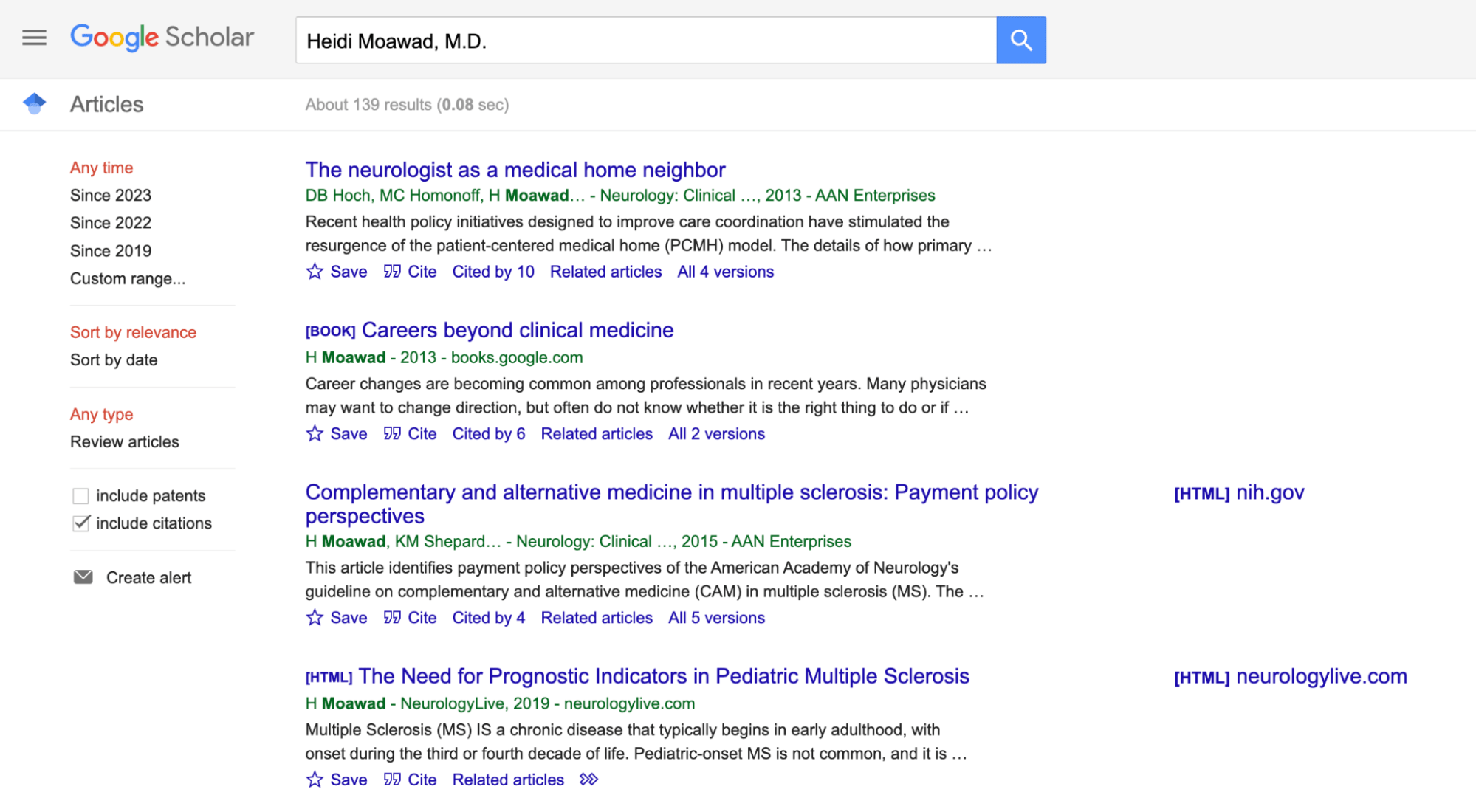
All of these things in academia are basically like backlinks in SEO. I won’t be surprised if all the data we’re showing here was interconnected on the entity level and that Google took it into consideration not only for enhancing the Knowledge Graph but also for rankings.
Speculations aside, Healthline already has all the highly authoritative backlinks that are so needed in this niche. We all expect that. But I took a look at a few personal websites from the Healthline’s editorial team and found some nice backlink profiles that signal E-E-A-T too:
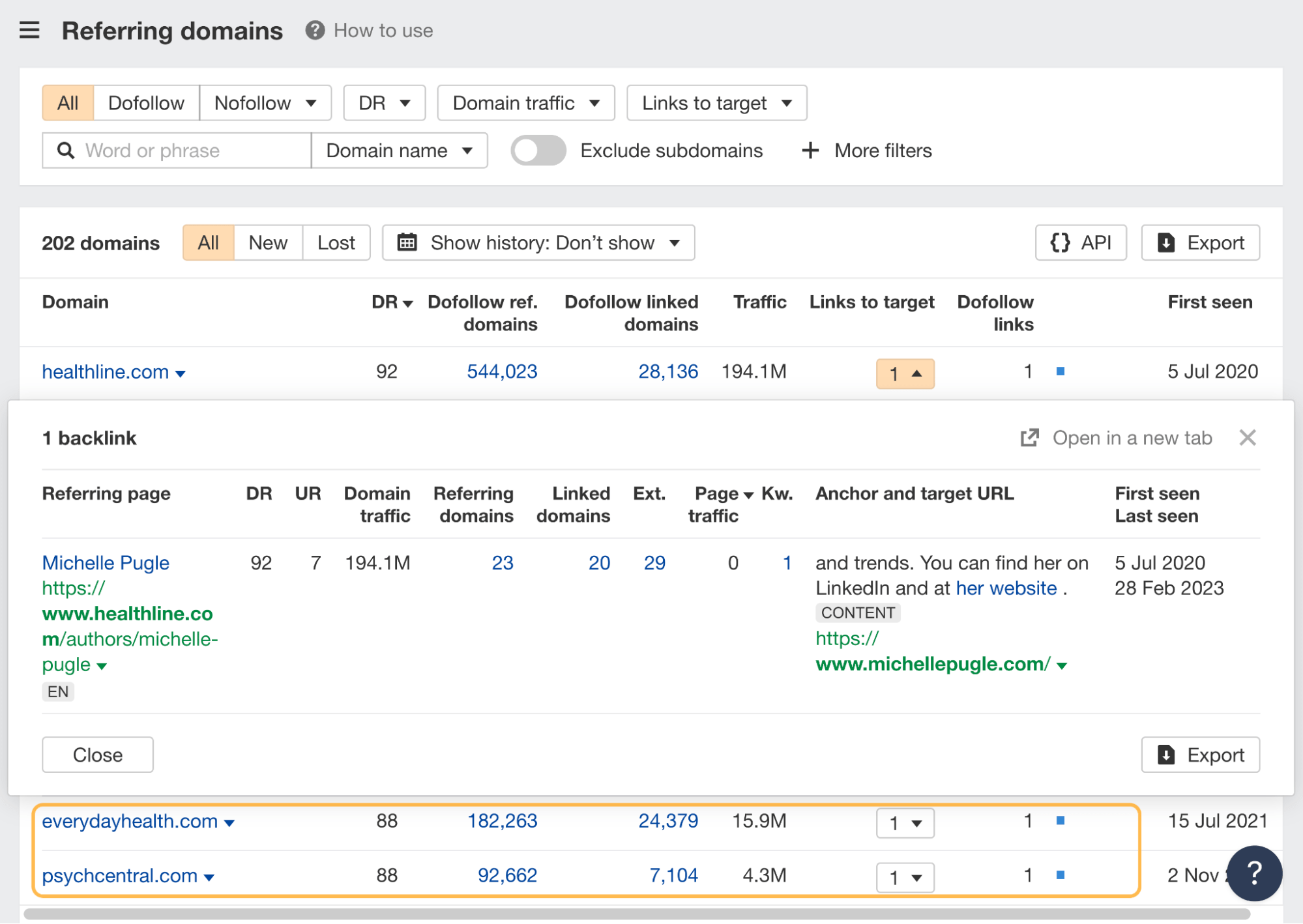
The takeaway is that the direct backlink profile is undoubtedly most important, but you can’t go wrong featuring great content from someone who already has a proven track record.
Meticulously describing editorial processes
Healthline has the most detailed and open documentation about its editorial processes, monetization, product selection, integrity, etc., that I’ve ever seen.
You can access all of this from its About page with a click or two.
For example, here’s an excerpt from its “product selection process” page that clearly signals the trustworthiness of its recommendations:
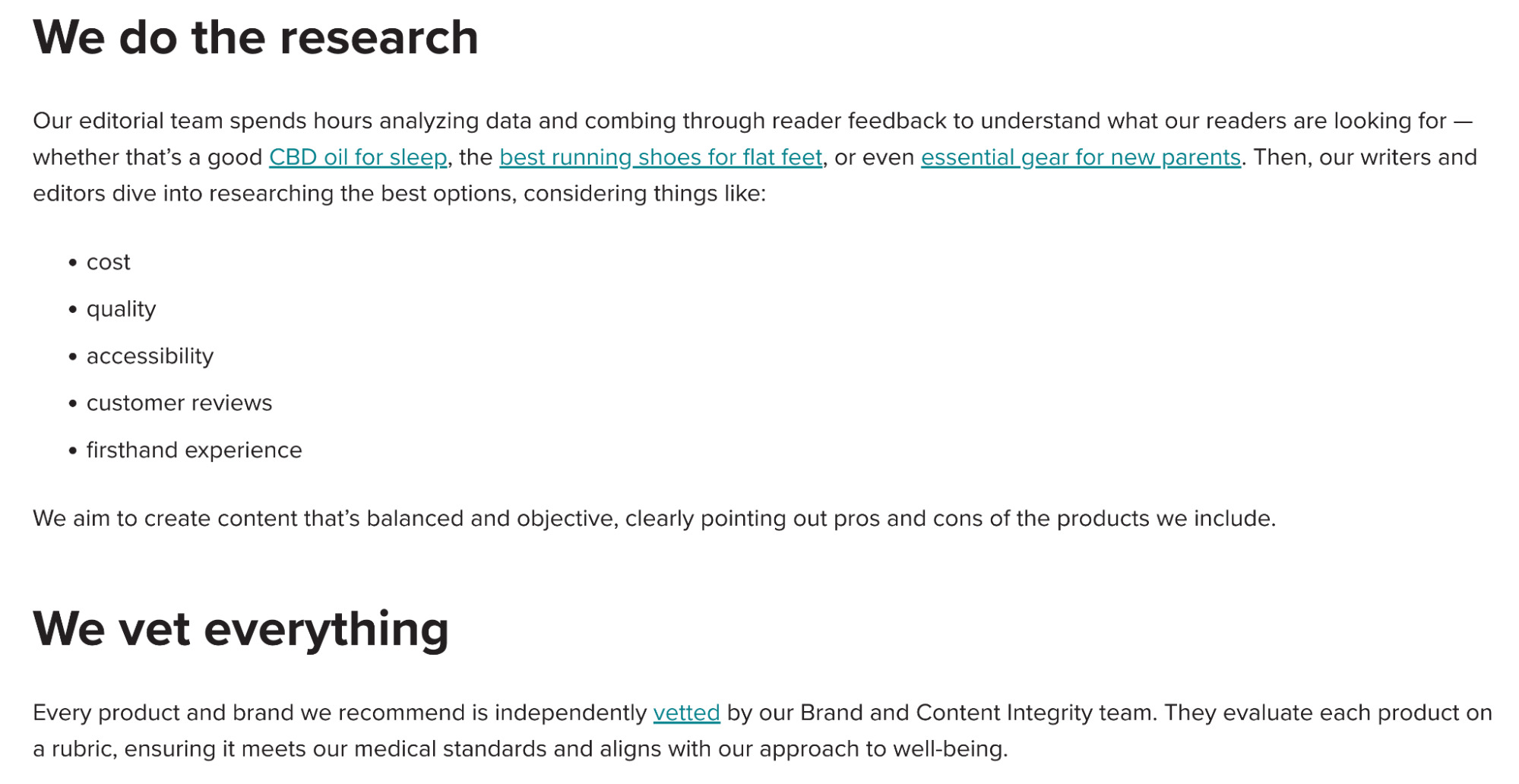
Adding a list of sources and references
Listing your sources is a great way to show the reader that the content is based on trustworthy information. Healthline includes those at the end of articles:
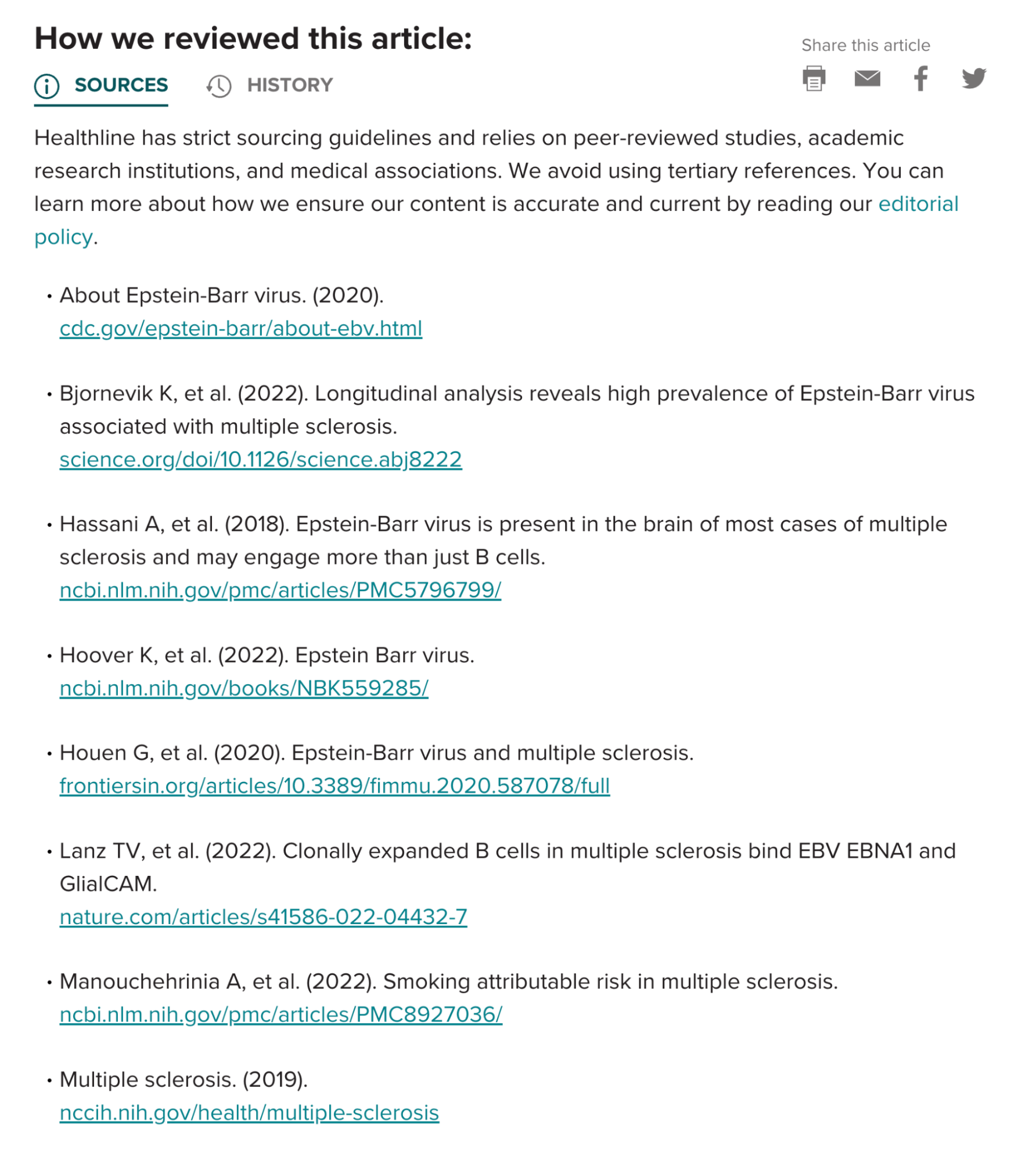
Keeping the history of edits and reviews
Health is one of those niches where almost no content can be considered evergreen. New research can sometimes even flip existing findings and best practices around.
Next to the Sources tab, Healthline also shows the History tab where we can see who has done what with the content and when:

Anthony Machi from Healthline’s SEO team said that they already had a 50:50 split for publishing new and updating old content back in 2022.
I can imagine that they already spend more time on the updates now. The number of new pieces published is significantly down recently when looking at the past five years:
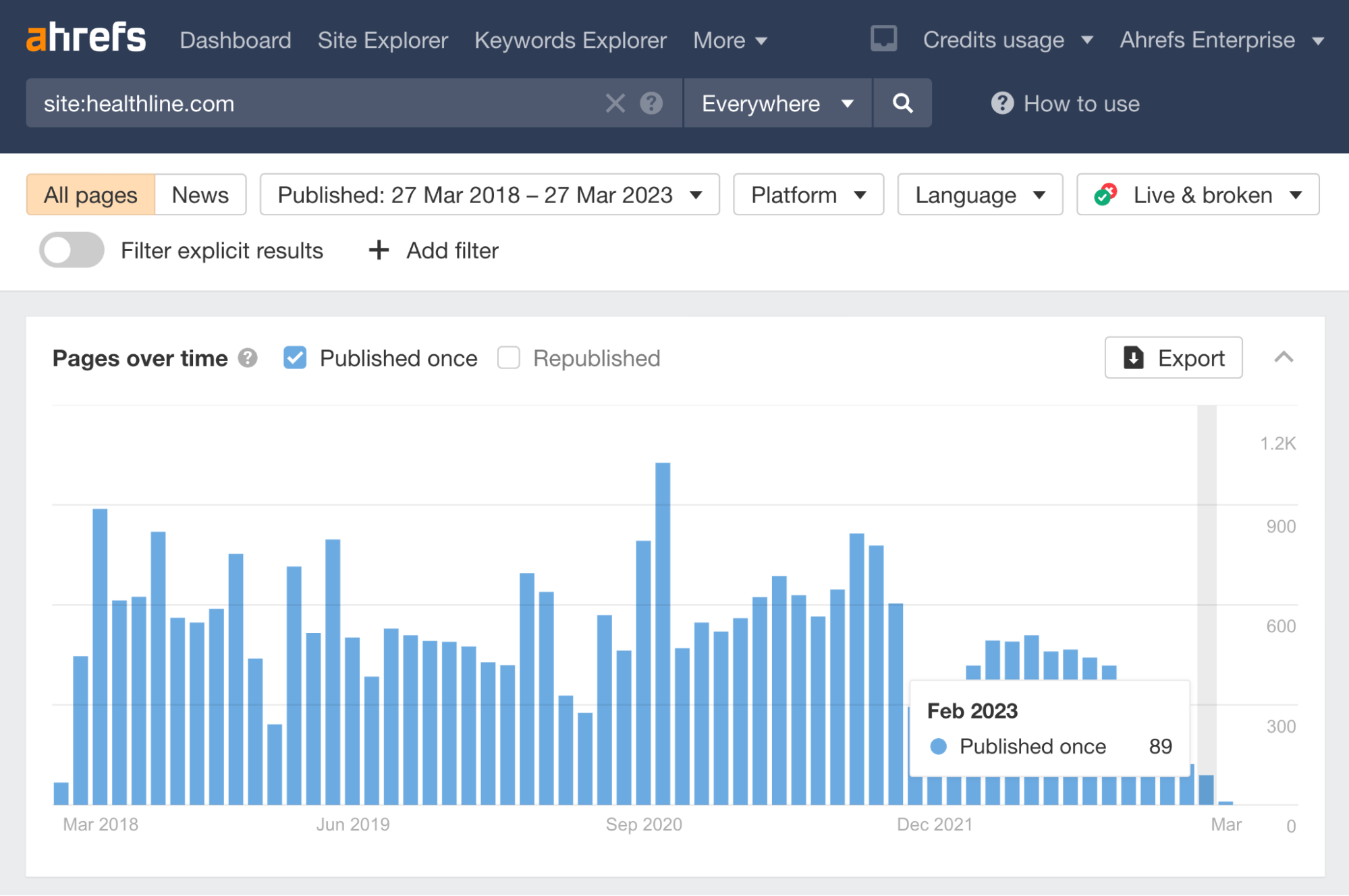
Final thoughts
Even though I spent many hours analyzing Healthline’s website from all sorts of angles, I’m sure there are many interesting SEO insights I still haven’t uncovered.
It’s a website anyone can take inspiration from to improve their own SEO and content game regardless of the niche they’re in.
Got any questions or comments? Let me know on Twitter.
SEO
Google To Upgrade All Retailers To New Merchant Center By September

Google has announced plans to transition all retailers to its updated Merchant Center platform by September.
This move will affect e-commerce businesses globally and comes ahead of the holiday shopping season.
The Merchant Center is a tool for online retailers to manage how their products appear across Google’s shopping services.
Key Changes & Features
The new Merchant Center includes several significant updates.
Product Studio
An AI-powered tool for content creation. Google reports that 80% of current users view it as improving efficiency.
This feature allows retailers to generate tailored product assets, animate still images, and modify existing product images to match brand aesthetics.
It also simplifies tasks like background removal and image resolution enhancement.
Centralized Analytics
A new tab consolidating various business insights, including pricing data and competitive analysis tools.
Retailers can access pricing recommendations, competitive visibility reports, and retail-specific search trends, enabling them to make data-driven decisions and capitalize on popular product categories.
Redesigned Navigation
Google claims the new interface is more intuitive and cites increased setup success rates for new merchants.
The platform now offers simplified website verification processes and can pre-populate product information during setup.
Initial User Response
According to Google, early adopters have shown increased engagement with the platform.
The company reports a 25% increase in omnichannel merchants adding product offers in the new system. However, these figures have yet to be independently verified.
Jeff Harrell, Google’s Senior Director of Merchant Shopping, states in an announcement:
“We’ve seen a significant increase in retention and engagement among existing online merchants who have moved to the new Merchant Center.”
Potential Challenges and Support
While Google emphasizes the upgrade’s benefits, some retailers, particularly those comfortable with the current version, may face challenges adapting to the new system.
The upgrade’s mandatory nature could raise concerns among users who prefer the existing interface or have integrated workflows based on the current system.
To address these concerns, Google has stated that it will provide resources and support to help with the transition. This includes tutorial videos, detailed documentation, and access to customer support teams for troubleshooting.
Industry Context
This update comes as e-commerce platforms evolve, with major players like Amazon and Shopify enhancing their seller tools. Google’s move is part of broader efforts to maintain competitiveness in the e-commerce services sector.
The upgrade could impact consumers by improving product listings and providing more accurate information across Google’s shopping services.
For the e-commerce industry as a whole, it signals a continued push towards AI-driven tools and data-centric decision-making.
Transition Timeline
Google states that retailers will be automatically upgraded by September if they still need to transition.
The company advises users to familiarize themselves with the new features before the busy holiday shopping period.
Featured Image: BestForBest/Shutterstock
SEO
Meta AI Introduces AI-Generated Photos to All Platforms

Meta just released multiple updates to Meta AI which brings advanced image generation and editing capabilities directly to Facebook, Instagram and WhatsApp feeds, plus availability in more countries and languages.
New Meta AI Creative Tools
Meta AI is bringing AI generated and AI Edited photography that can be generated at the moment a user is making a post or sending a message with a new tool called Imagine Me.
Imagine Me is a prompt that can be used to transform an uploaded image that can be shared. This new feature is first rolling out as a beta in the United States.
Meta explains:
“Imagine yourself creates images based on a photo of you and a prompt like ‘Imagine me surfing’ or ‘Imagine me on a beach vacation’ using our new state-of-the-art personalization model. Simply type “Imagine me” in your Meta AI chat to get started, and then you can add a prompt like “Imagine me as royalty” or “Imagine me in a surrealist painting.” From there, you can share the images with friends and family, giving you the perfect response or funny sidebar to entertain your group chat.”
New Editing Features
Meta products like Facebook, Messenger, WhatsApp and Instagram now have advanced editing capabilities that allow users to add or remove objects from images, to change them in virtually any manner, such as their example of turning a cat in an image into a dog. A new Edit With AI button is forthcoming in a month that will unlock even more AI editing power.
Adding AI generated images to Facebook, Instagram, Messenger and WhatsApp within feed, posts, stories, comments and messages is rolling out this week in English and coming later to other languages.

Meta AI In More Countries And Languages
Meta AI is now available in seven additional countries, bringing the total countries to to 22. It is also available in seven more languages.
List of Seven Additional Countries:
- Argentina
- Cameroon
- Chile
- Colombia
- Ecuador
- Mexico
- Peru
Meta AI is now also available in the following seven additional languages:
- French
- German
- Hindi
- Hindi-Romanized Script
- Italian
- Portuguese
- Spanish
Advanced Math And Coding
Meta AI is making their most advanced model, Llama 405B, available for users to take advantage of its advanced reasoning abilities that can answer complex answers and excells at math and coding.
Meta AI writes:
“You can get help on your math homework with step-by-step explanations and feedback, write code faster with debugging support and optimization suggestions, and master complex technical and scientific concepts with expert instruction.”
Read the official announcement:
Meta AI Is Now Multilingual, More Creative and Smarter
Featured Image by Shutterstock/QubixStudio
SEO
System Builders – How AI Changes The Work Of SEO

AI is terraforming tech. The content and SEO ecosystem is undergoing a massive structural change.
Human-written content gains value faster for LLM training than for end consumers as the pure profit licensing deals between LLM developers and publishers show.
Publishers struggle to survive from digital subscriptions but get millions that go straight to their bottom line for providing training data.
Content platforms, social networks, SaaS companies and consumer apps coat their products with AI. A few examples:
- Spotify DJ (AI-generated playlist).
- AI Overview (AI answers in Google Search).
- Instagram AI personas (celebrity AI chatbots).
- Ebay’s magical listing (turn a photo into a listing).
- Redfin Redesign (try interior designs on real house pictures).
The quality of machine-generated content (MGC) challenges human-generated content (HGC). I ran an experiment with my Twitter and LinkedIn followers: I asked them to choose which of two articles was written by a human and which by a machine – and they had to explain their answer.
Only a handful of people figured out that AI wrote both pieces. I intentionally framed the question in a leading way to see if people would challenge the setting or believe that one piece was written by a human if told so.
- Not an isolated experiment: A survey of 1,900 Americans found that 63.5% of people can’t distinguish between AI content and human content.1
- People seek help: Google search demand for [ai checker] has reached 100,000 in May 2024 (Glimpse).
- Dark side: scammers use MGC to make money, as 77% of AI scam victims lost money.2
 Image Credit: Kevin Indig
Image Credit: Kevin IndigThe quality level of LLMs pushes SEO work towards automating workflows and learning with AI, while writers will take content from good to great instead of zero to one.
Boost your skills with Growth Memo’s weekly expert insights. Subscribe for free!
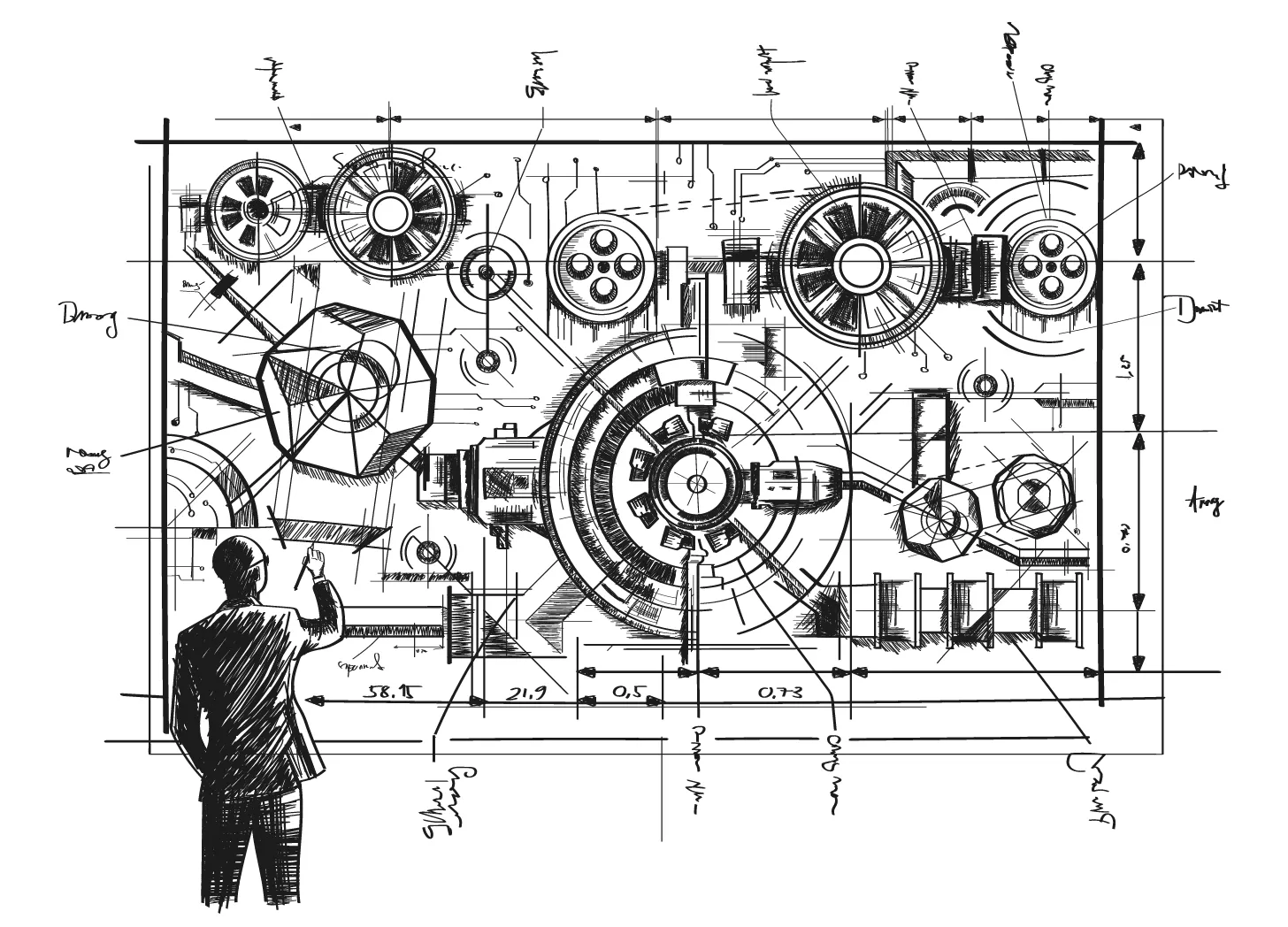 Image Credit: Lyna ™
Image Credit: Lyna ™System Builders
Clients, podcasters and panel hosts often ask me what skills SEOs need to build for the AI future. For a long time, my answer was to learn, stay open-minded and gain as much practical experience with AI as possible.
Now, my answer is SEOs should learn how to build AI agents and workflows that automate tasks. AI changes the way search works but also the way SEOs work.
AI + No-code Allows SEOs To Automate Workflows
A few examples:
1/ Cannibalization
- Old world: SEOs download search console data and create pivot tables to spot keyword cannibalization.
- New world: SEOs build an AI workflow that sends alters, identifies true keyword cannibalization, makes content suggestions to fix the problem, and monitors the improvement.
2/ Site Crawling
- Old world: SEOs crawl websites to find inefficiencies in internal linking, status code errors, duplicate content, etc.
- New world: SEOs build an AI agent that regularly crawls the site and automatically suggests new internal links that are shipped after human approval, fixes broken canonical tags and excludes soft 404 errors in the robots.txt.
3/ Content Creation
- Old world: SEOs do keyword research and write content briefs. Writers create the content.
- New world: SEOs automate keyword research with AI and create hundreds of relevant articles as a foundation for writers to build on.
All of this is already possible today with AI workflow tools like AirOps or Apify, which chain agents and LLMs together to scrape, analyze, transform data or create content.
Moving forward, we’ll spend much more time building automated systems instead of wasting time on point analyses and catalogs of recommendations. The SEO work will be defining logic, setting rules, prompting and coding.
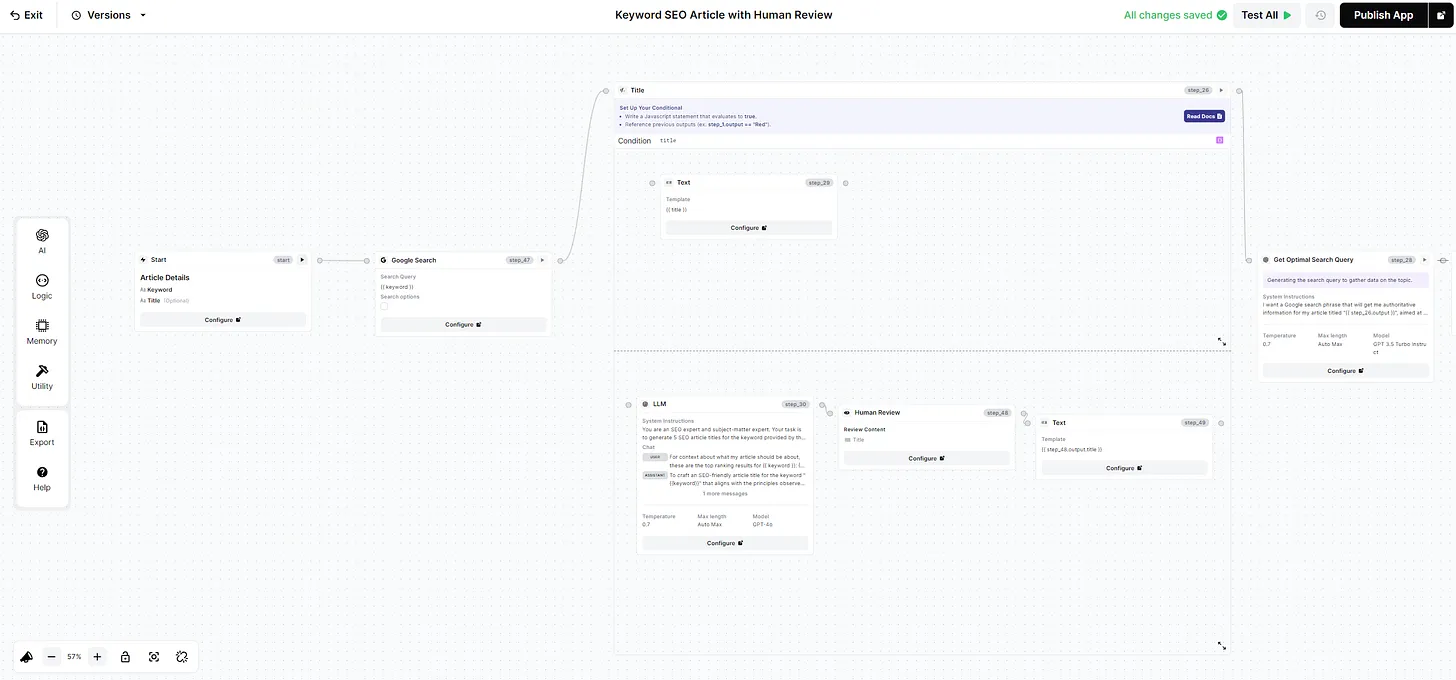 Building workflows with AirOps (Image Credit: Kevin Indig)
Building workflows with AirOps (Image Credit: Kevin Indig)You Can Learn (Almost) Anything With AI
I never made the time to really learn Python or R, but with the help of Chat GPT and Gemini in Colab, I can write any script with natural language prompts.
When the script doesn’t work, I can paste a screenshot into Chat GPT and describe the issue to get a solution. AI helps with Regex, Google Sheets/Excel, R, Python, etc. Nothing is off-limits.
Being able to write scripts can solve problems like data analysis, a/b testing and using APIs. As an SEO, I’m no longer dependent on engineers, data scientists or writers to perform certain tasks. I can act faster and on my own account.
I’m not the only one to figure this out. People are learning to code, write and many other skills with AI. We can learn to build AI workflows by asking AI to teach us.
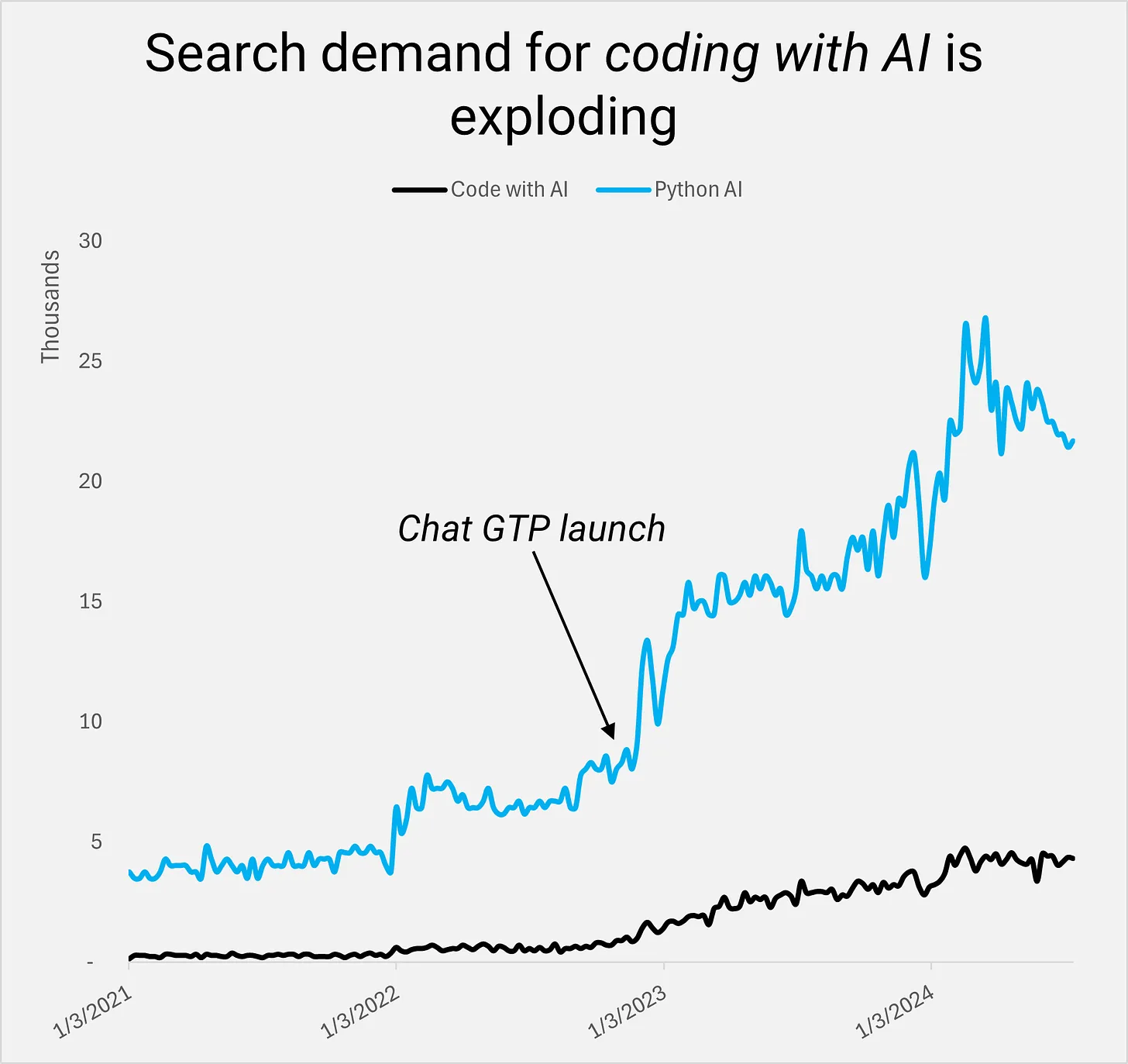 Image Credit: Kevin Indig
Image Credit: Kevin Indig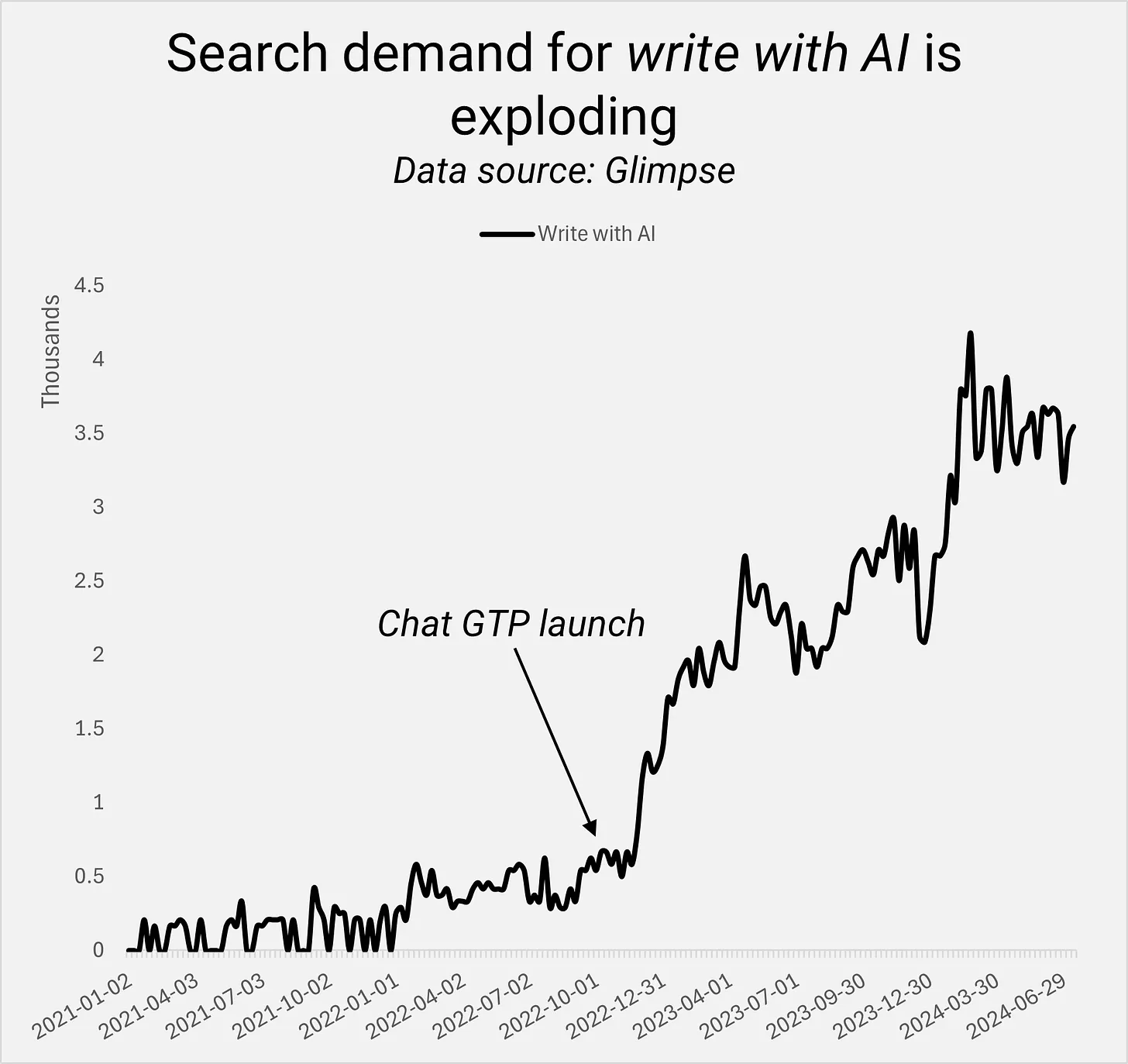 Image Credit: Kevin Indig
Image Credit: Kevin Indig Image Credit: Kevin Indig
Image Credit: Kevin IndigWhen you can learn almost anything, the only limit is time.
The Work Of Writers Changes
Against common belief, writers won’t be crossed out of this equation but will play the critical role of editing, directing and curating.
In any automated process, humans QA the output. Think of car assembling lines. Even though AI content leaps in quality, spot checks reduce the risk of errors. Caught issues, such as wrong facts, weird phrasing or off-brand wording, will be critical feedback to fine-tune models to improve their output.
Instead of leg work like writing drafts, writers will bring AI content from good to great. In the concept of information gain, writers will spend most of their time making a piece outstanding.
The rising quality work spans from blog content to programmatic content, where writers will add curated content when searches have a desire for human experience, such as in travel.
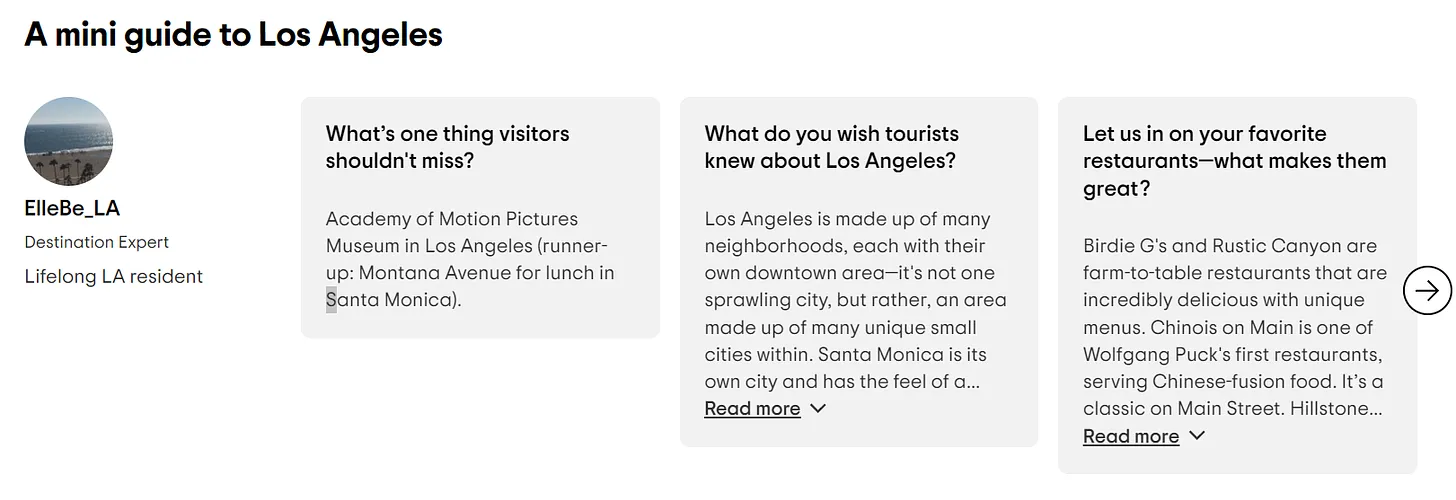 Tripadvisor’s attraction pages feature human-curated sections. (Image Credit: Kevin Indig)
Tripadvisor’s attraction pages feature human-curated sections. (Image Credit: Kevin Indig)Unfair Advantage
As often with new technology, a few first-mover people and companies get exponential value until the rest catch up. My worry is that a few fast-moving companies will grab massive land with AI.
And yet, this jump in progress will allow newcomers to challenge incumbents and get a fair chance to compete on the field.
AI might be a bigger game changer for SEOs than for Google. The raw power of AI might help us overcome challenges from AI Overviews and machine learning-driven algorithm updates.
But the biggest win might be that SEOs can finally make something instead of delivering recommendations. The whole value contribution of SEOs changes because my output can drive results faster.
Survey: ChatGPT and AI Content – Can people tell the difference?
Artificial Intelligence Voice Scams on the Rise with 1 in 4 Adults Impacted
Featured Image: Paulo Bobita/Search Engine Journal
-

 SEO7 days ago
SEO7 days agoWhat SEO Should Know About Brand Marketing With Mordy Oberstein
-
SEARCHENGINES7 days ago
Daily Search Forum Recap: July 18, 2024
-

 AFFILIATE MARKETING6 days ago
AFFILIATE MARKETING6 days agoWhy Taylor Swift Believes in Her Lucky Number
-
SEARCHENGINES6 days ago
Daily Search Forum Recap: July 19, 2024
-

 SEO7 days ago
SEO7 days ago4 Ways PPC and SEO Can Work Together (And When They Can’t)
-

 SEO7 days ago
SEO7 days agoHow to Get Search Traffic Without Ranking for Anything
-

 SEO5 days ago
SEO5 days ago26 Common SEO Myths, Debunked
-

 SEARCHENGINES3 days ago
SEARCHENGINES3 days agoBillions Of Google goo.gl URLs To 404 In The Future










